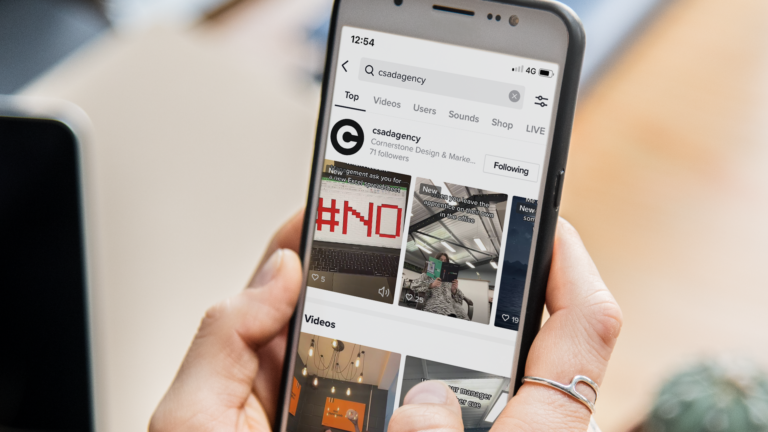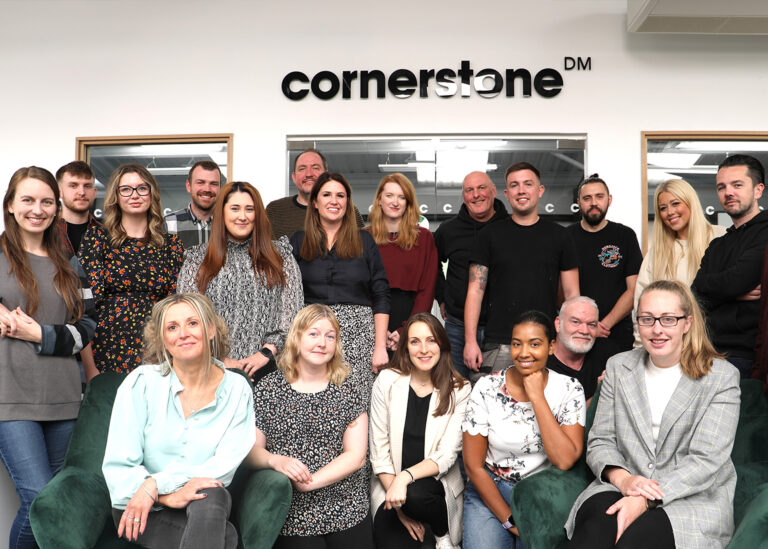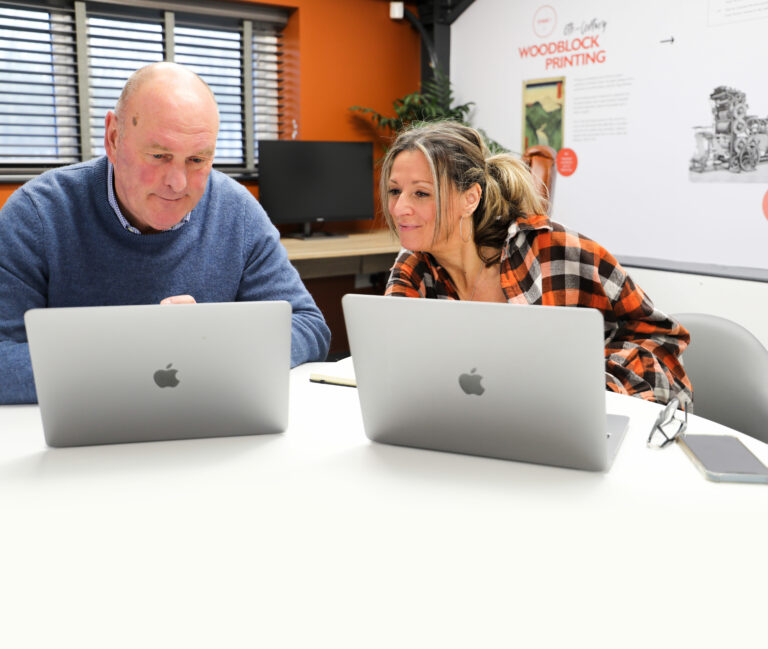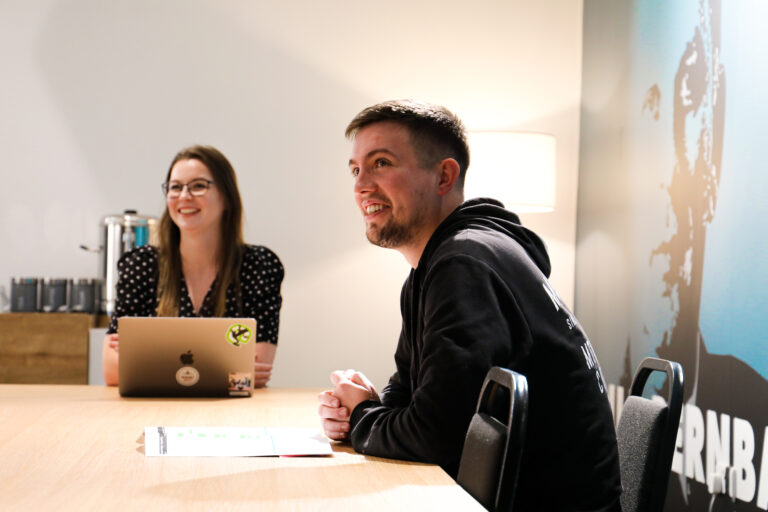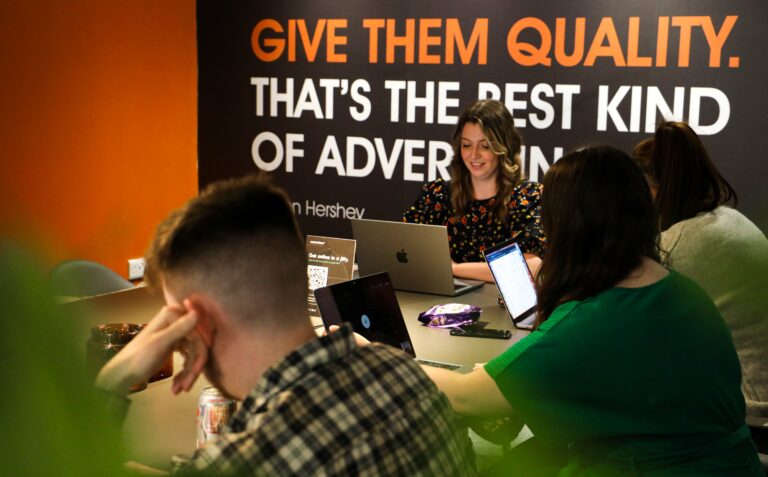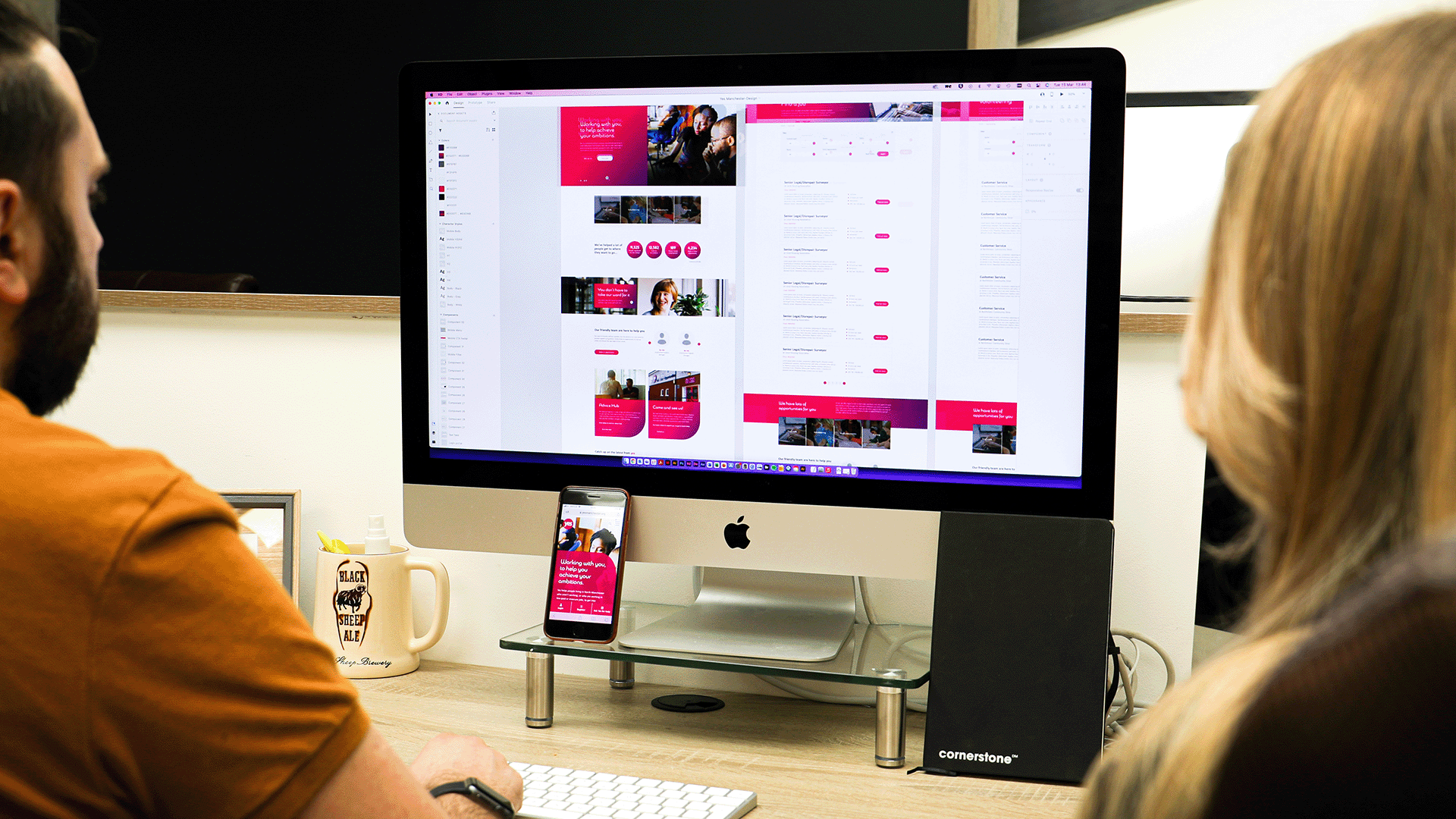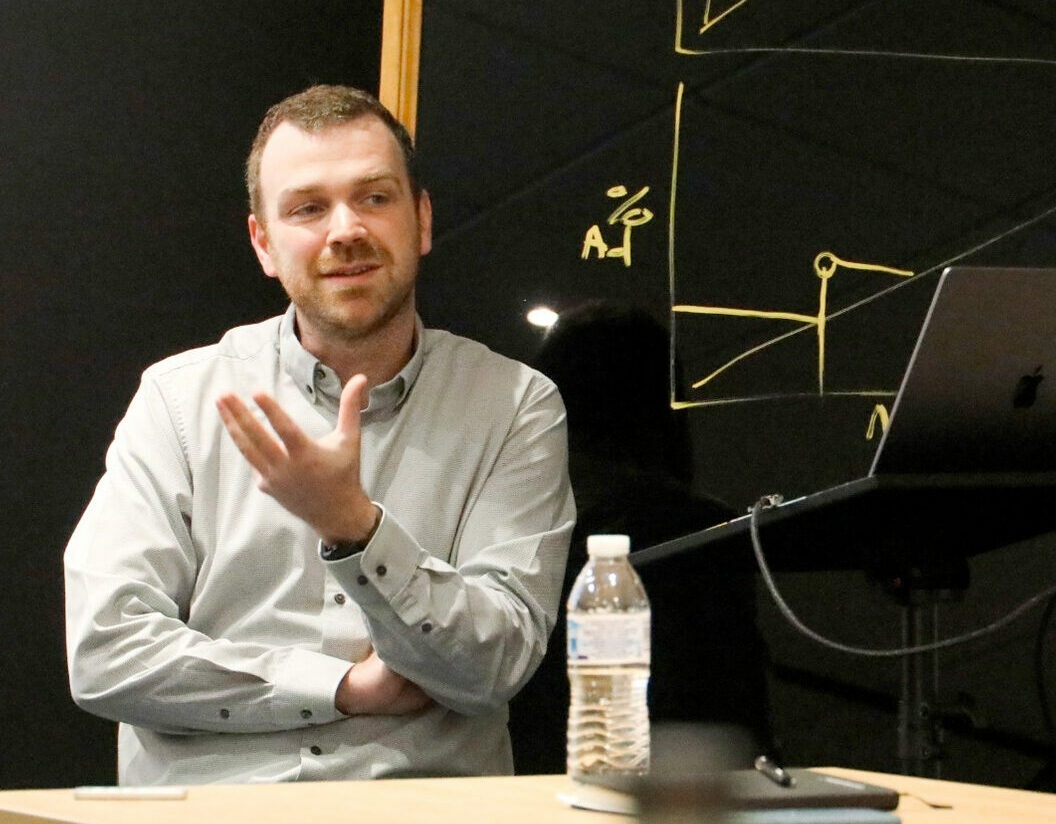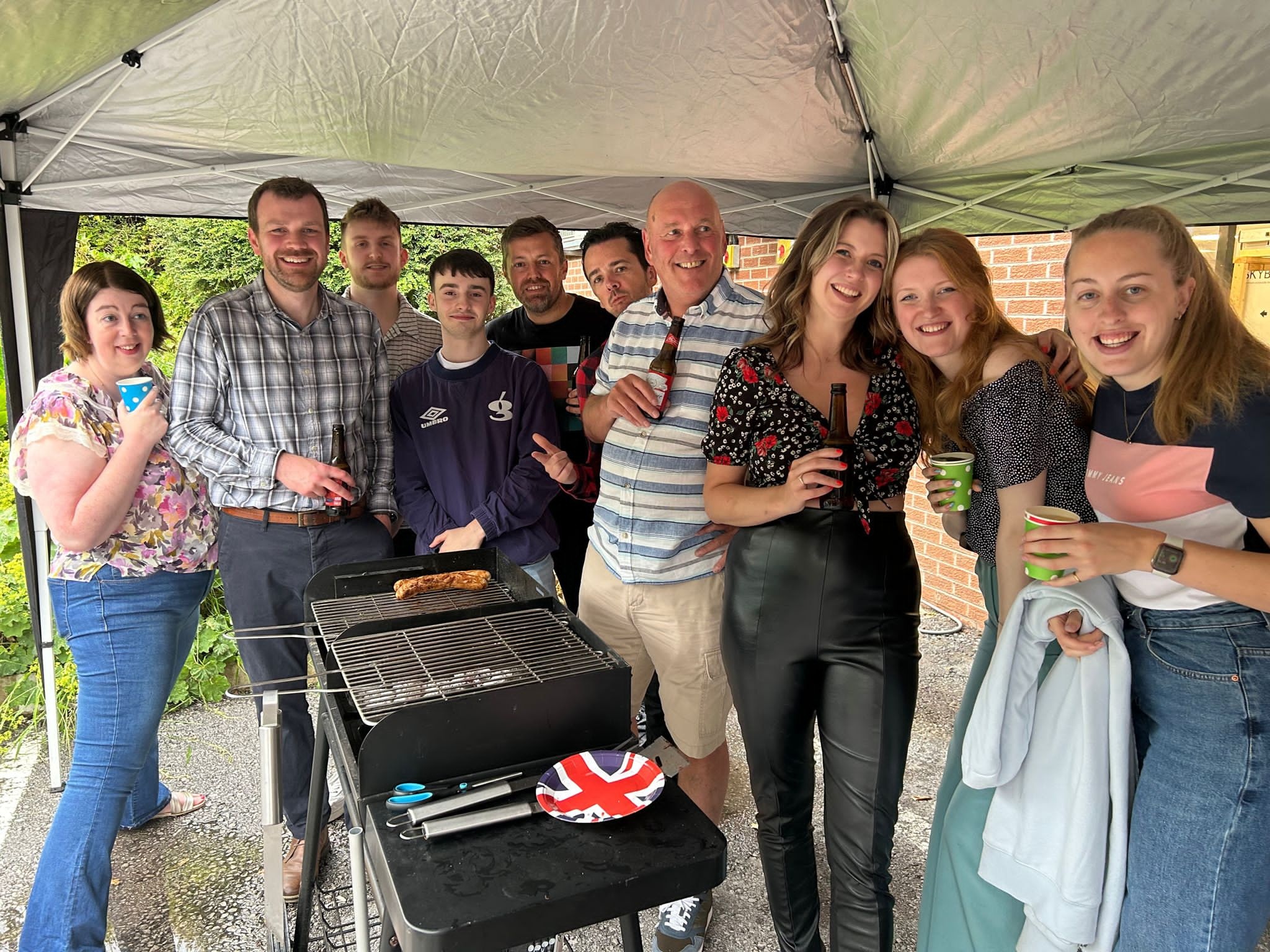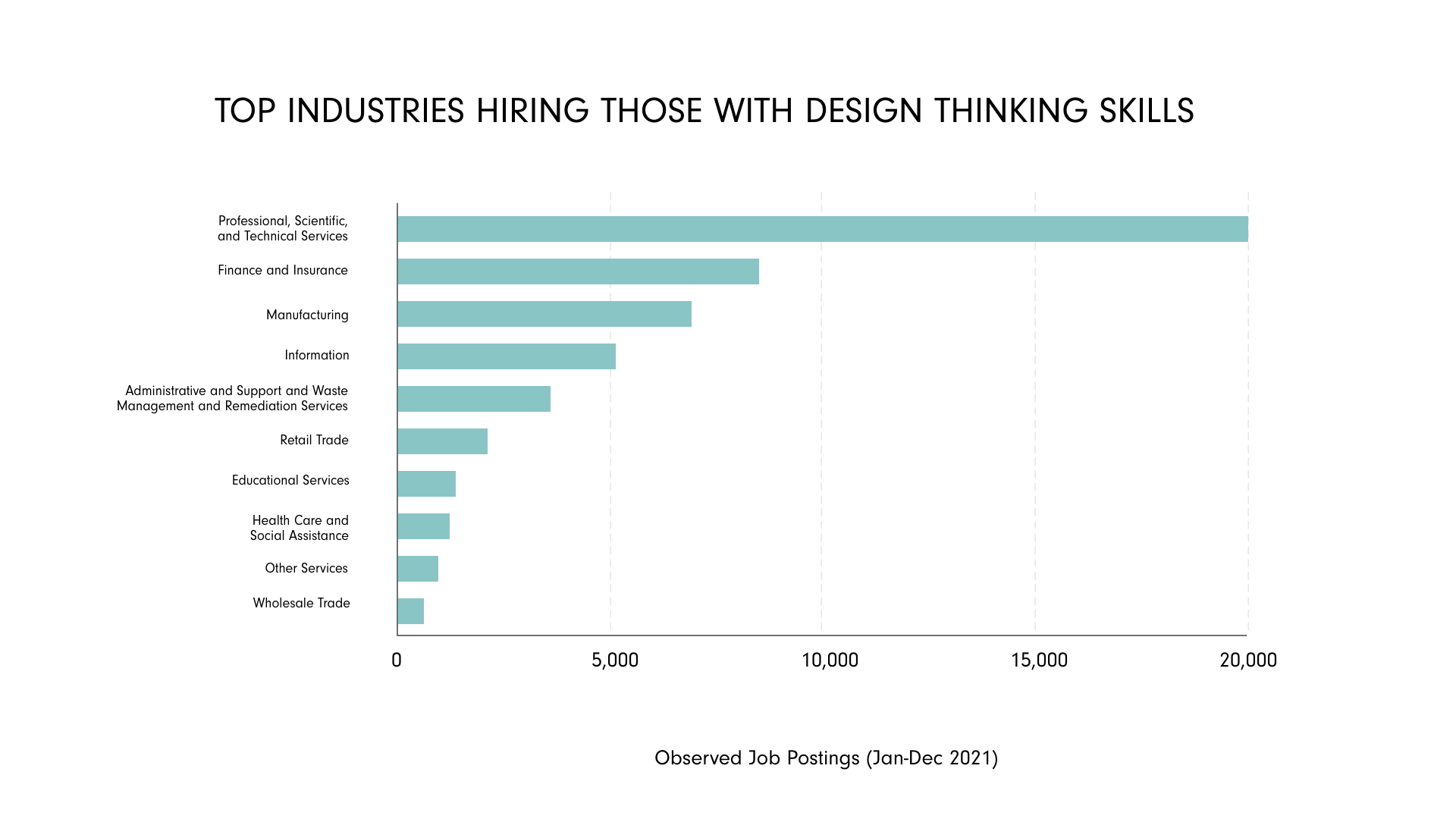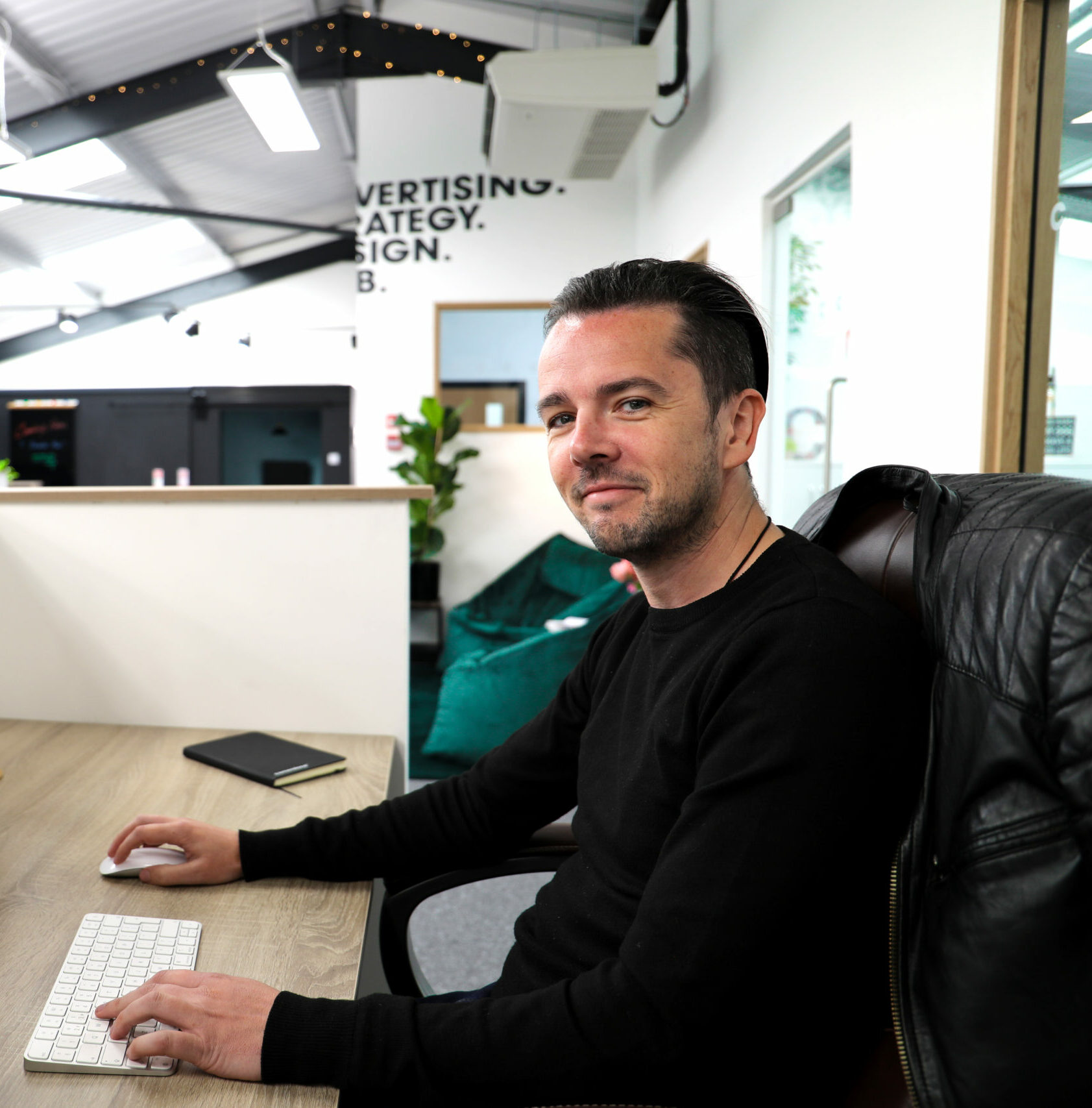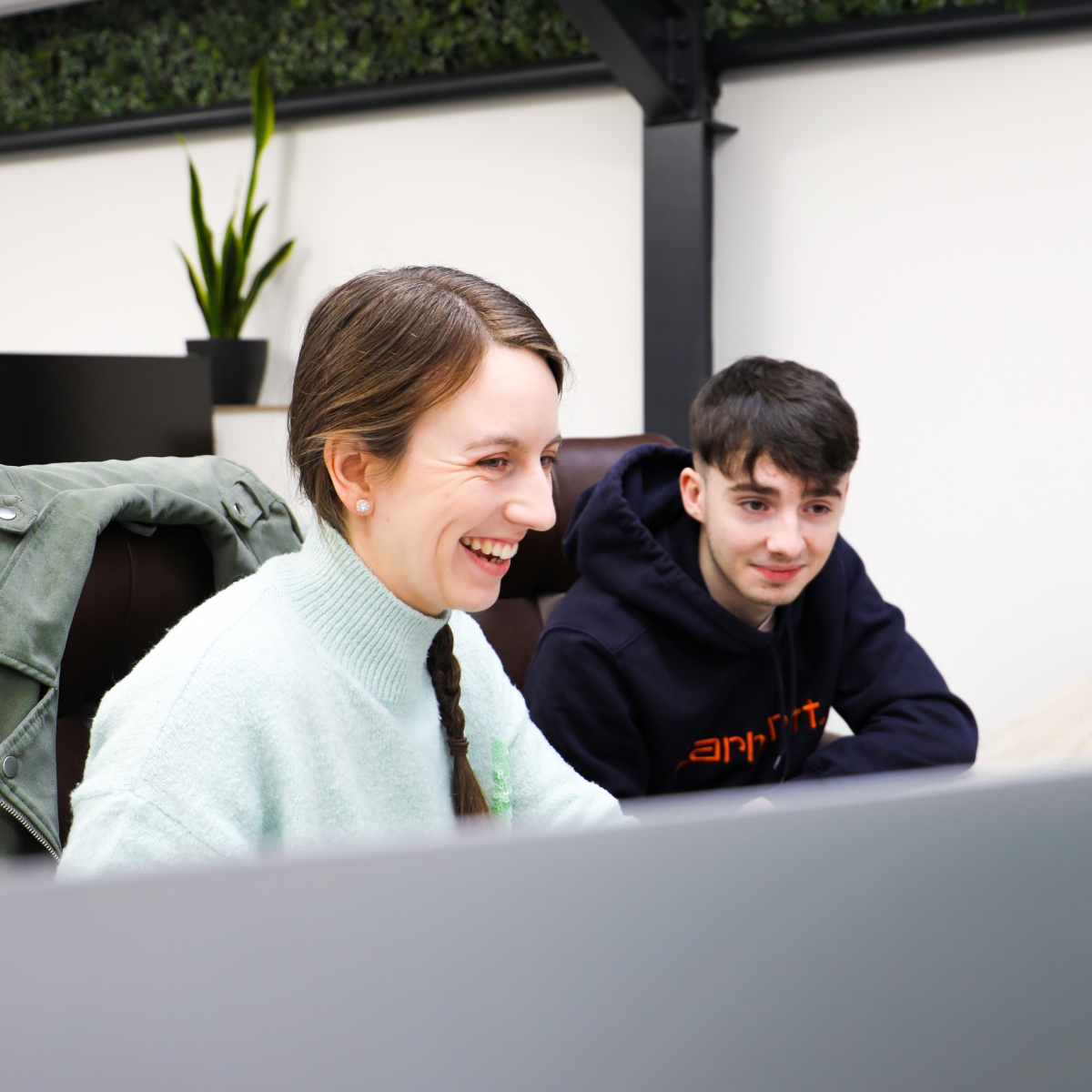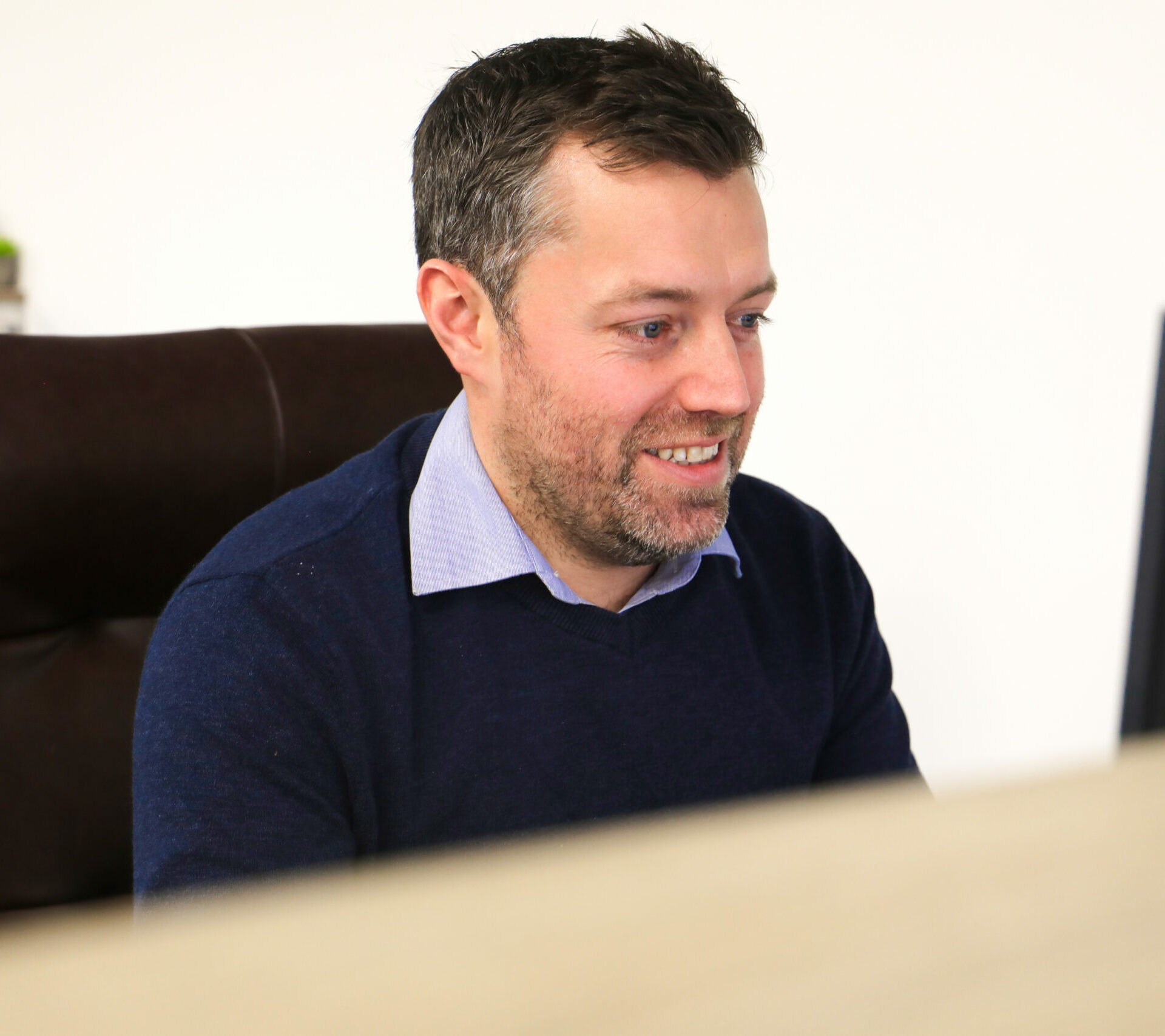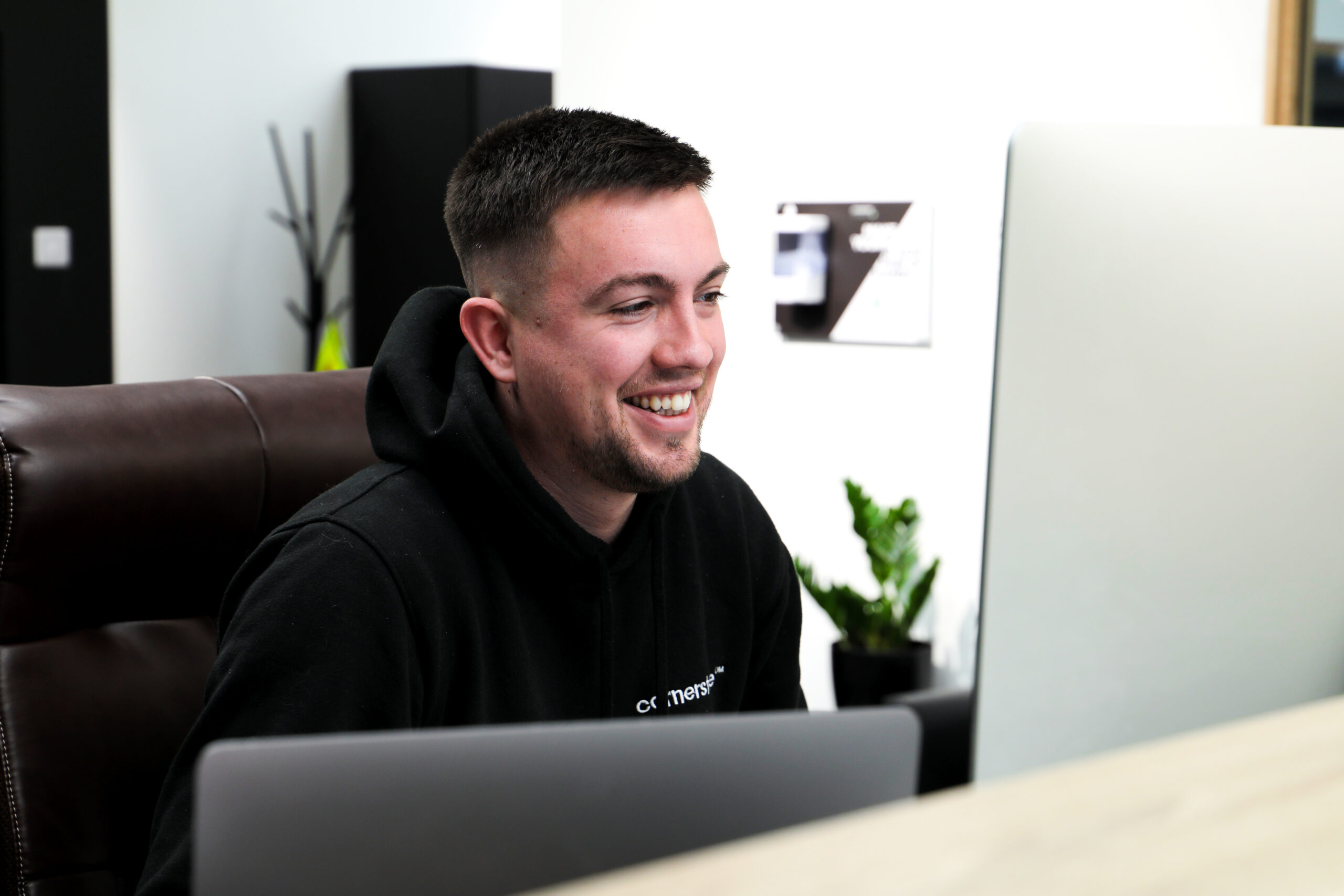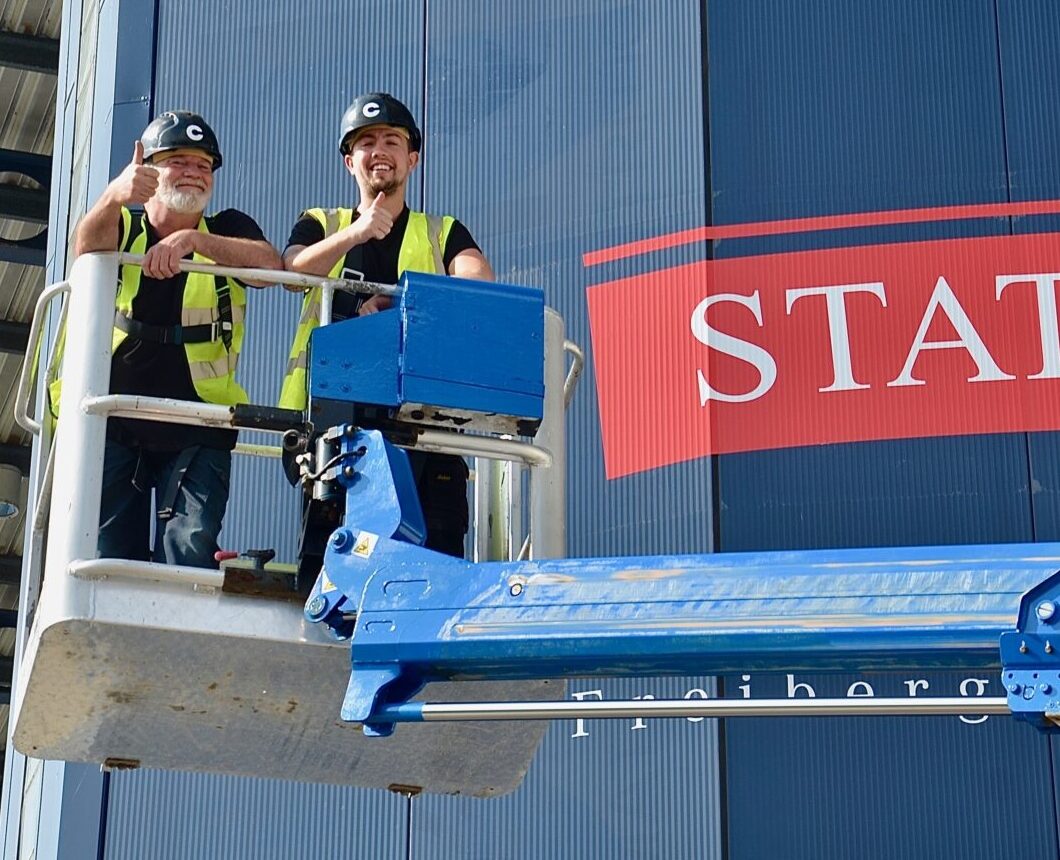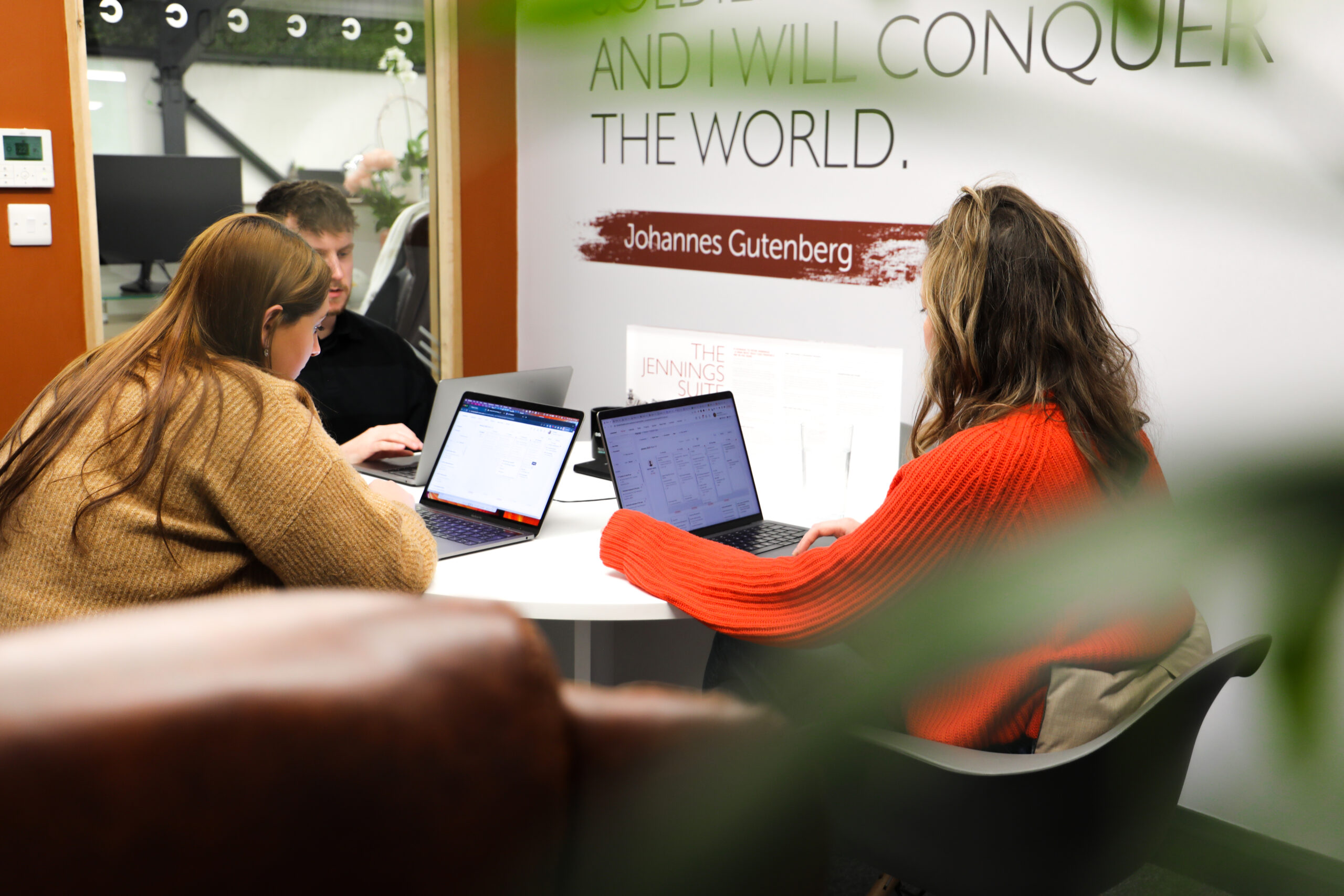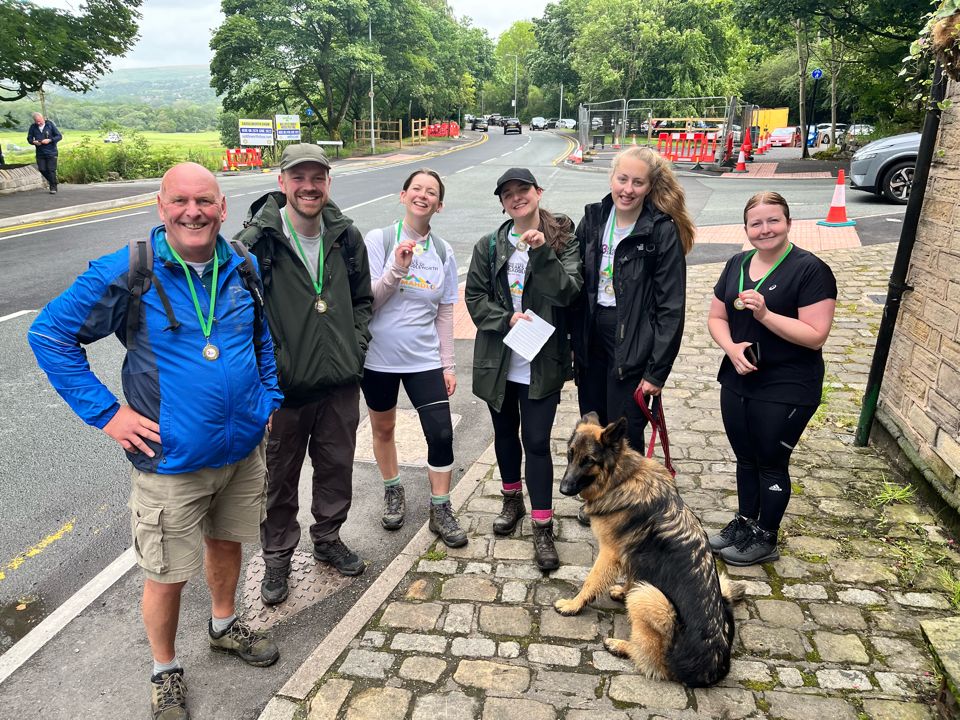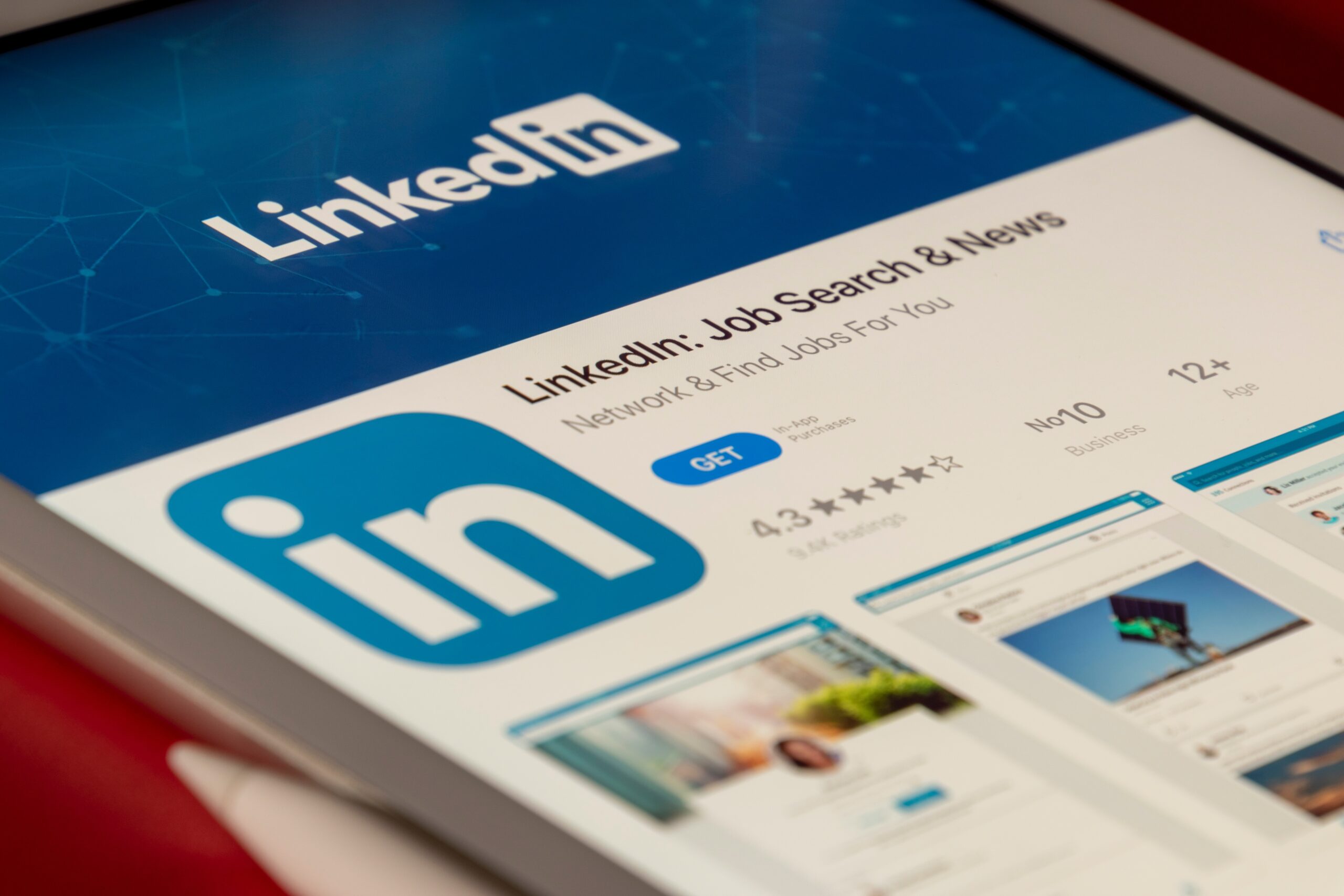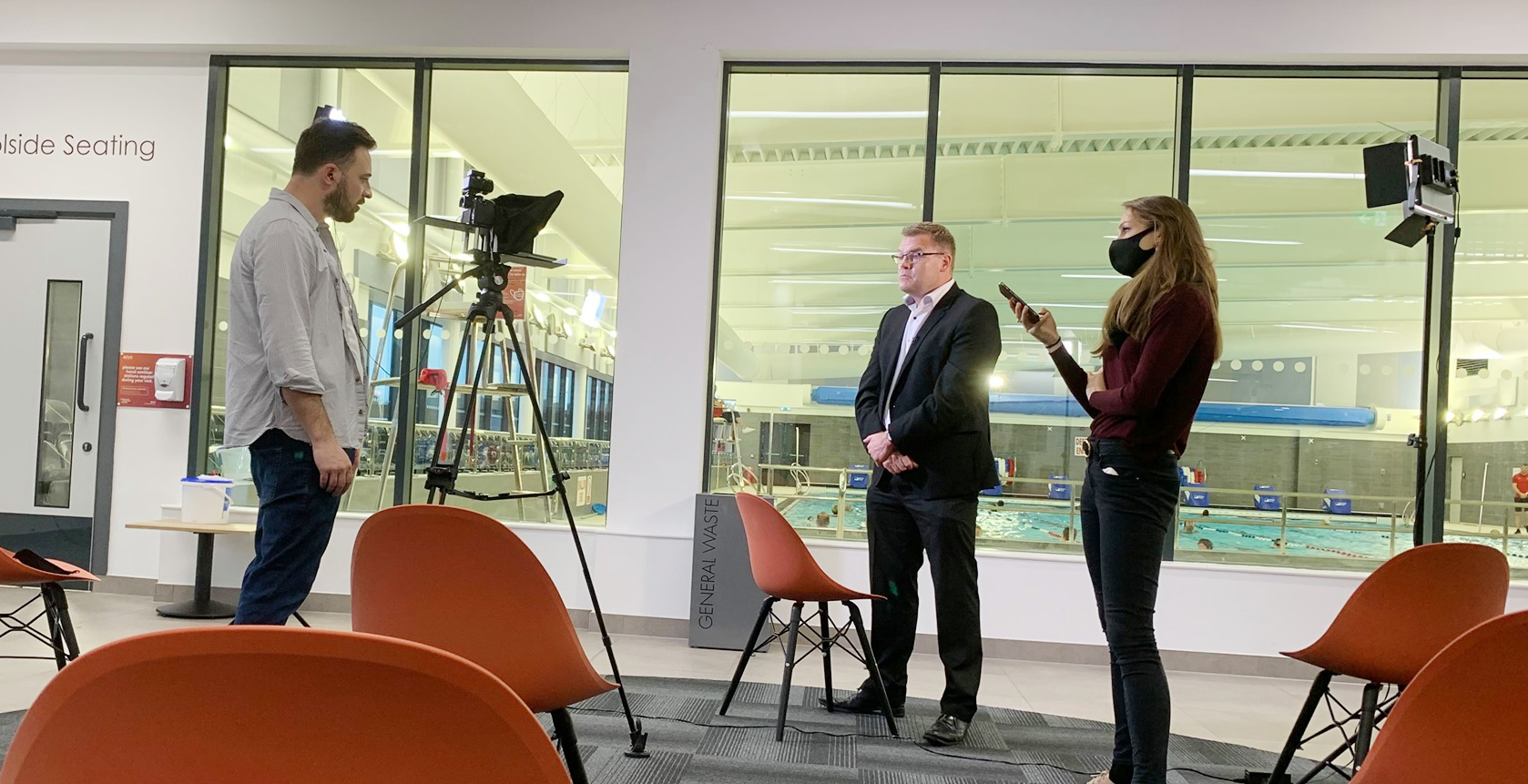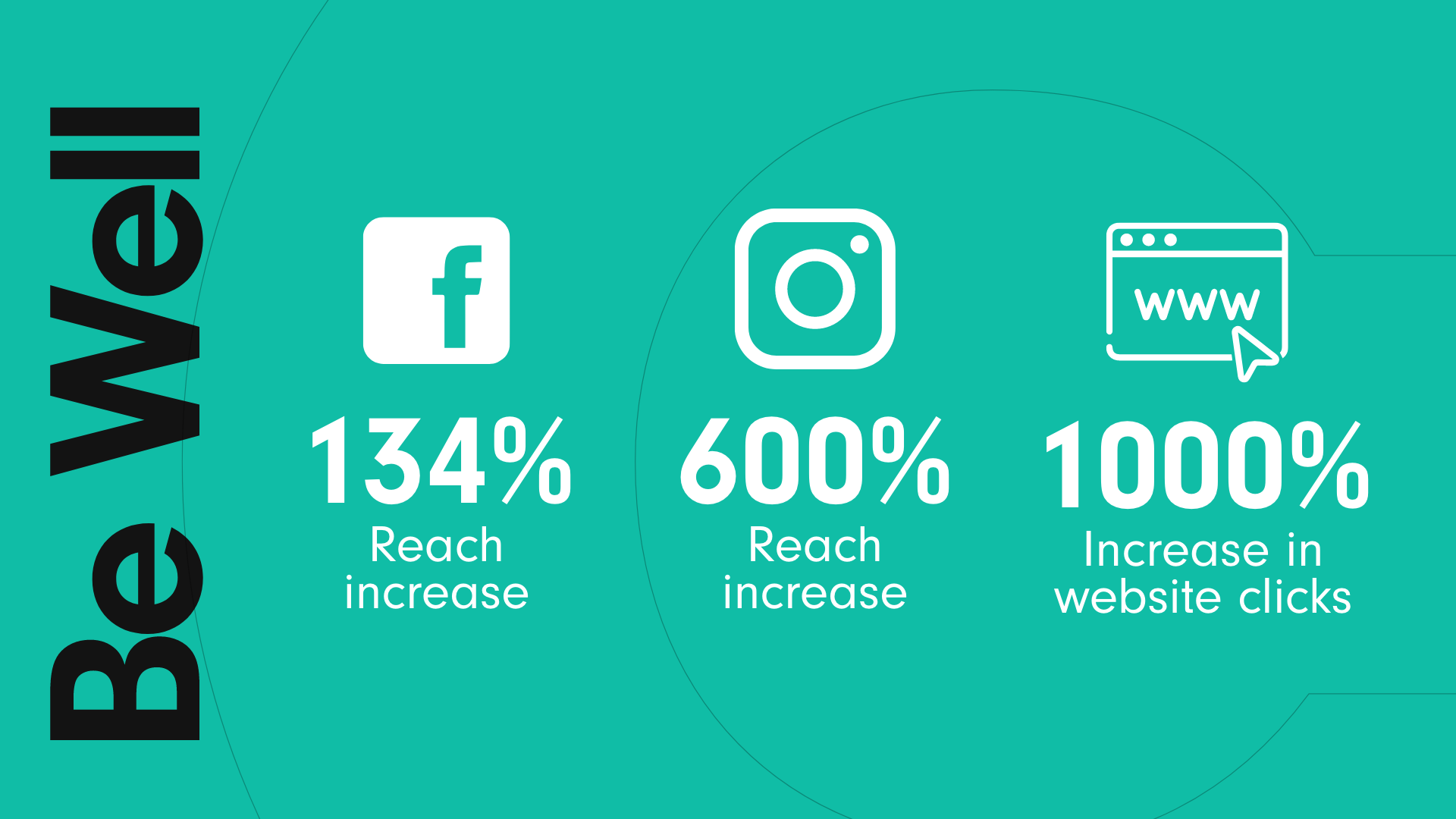The Ultimate 12 Step Guide to Growing an eCommerce Business Online
How do you create a successful eCommerce website though that does more than just sell?
Before we embark on growing understanding of developing a successful eCommerce website, we want to understand what makes an eCommerce website?
Online eCommerce as we know it today started a few years after the inception of the worldwide web when, in 1994, an online book shop, Book Stacks Unlimited, opened their Internet shop Books.com. This was a few short years before Amazon was founded, but by the mid-90s major marketplaces like eBay and Amazon started to make themselves known. Online eCommerce payment systems like PayPal then followed in 1997. Though they were online, business was not booming. Many were sceptical of the new online eCommerce trade, cautious of scams and fraud. So, improving customer experience and instilling confidence in their users was the obvious solution to increasing sales, and a tactic still employed by eCommerce website owners today.
In its most basic form, an eCommerce website can be defined as a business model that facilitates online sales.
An eCommerce website can be easily identified by its features very similar to physical shops; the ability to browse products, arrange delivery, and pay online.

1. Customer Goals
Before creating or fundamentally updating your eCommerce website, you should always take the time to research and understand what it is your customer wants. Each business and consumer is different, but a couple of consumer goals are universal…
An easy shopping experience
Every online shopping experience boils down to the consumer wanting to find their product, quickly, and to be able to purchase it, seamlessly.
Making the customer shopping experience as easy as possible is key to increasing sales, new and returning. We’ll explore exactly how you can do this through examining user experience, design and development but always consider who your consumer is and how they’re interacting with your website to help inform your decisions.
Using tools like Google Analytics, or heatmapping software, can help you understand exactly what users are doing on site, how they’re getting to your site, and identifying blocks to customer goals.
Know that they’re making the right choice
Not only in the product they’re purchasing but the company they’re purchasing it from.
Your credibility, responsibility and sustainability as a business is becoming a growing factor in the customer purchase decision so making sure you’re communicating your values and instilling confidence, is paramount.
2. Your Goals
Aligning your own business goals with your customer goals is a recipe for success.
Sales are an ultimate goal, but there’s also consideration for spotlighting your brand, generating brand loyalty and encouraging repeat, up or cross sales.
Understanding the ways in which you can achieve your goals while nurturing and achieving customer goals makes everyone a winner.
How to Build an Ecommerce Website
3. User Experience (UX)
Once you’ve understood every goal your eCommerce website needs to facilitate, you can start mapping out the structure of your website with user experience (UX) front-of-mind.
UX focuses on the usability and help to make websites and apps more intuitive, especially when it comes to the number one way-finder within a user journey: the navigation.
Clear, well-structured navigation menus make it easier for the user to find the products they’re looking for, as well as positioning related products in front of them to increase your chance of up or cross selling.
UX can also streamline the checkout process, allowing customers to make purchases quickly.
Ultimately, starting your eCommerce web or app development with a robust UX strategy and wireframes will help to give your customers the best possible experience and increase your conversion rates and revenue.
A Cornerstone UX workshop in progress

4. Website Design
The design of your eCommerce website is critical; colours (or lack of), fonts, page layouts, images and graphics all play an important part in facilitating yours and your customers’ goals.
Furthermore, with consumers browsing across multiple devices on multiple occasions, it’s important that your website is responsive and works just as hard whether it’s on mobile, desktop or tablet.
eCommerce sites should follow a relatively clean design with a clear and simple layout. This is especially important on product pages so that the consumer focuses on the product they want to buy (and that you want to sell!). Minimal distractions equals maximum selling potential!
An intuitive interface on-site so users can quickly navigate through and select any specific colours or sizes before adding to basket, helps to facilitate the easy customer journey we’re aiming for. Adding colour in the right way, to the right elements can also help make specific journeys, buttons or promo messages stand out to help your user get to their end goal quicker too.
And finally, high-quality images are a must. The bigger image, the quicker consumers can identify the product they want to buy. Going big over small when it comes to images also instils confidence. There’s no point trying to show off a quality product with a low-quality image that could read as a bit of a ‘scam’. Design is your first opportunity to instil brand confidence.
5. Development
Developing an eCommerce website is more than just bringing the design to life to ensure a smooth user experience.
There are more facets and complexities to building an eCommerce site. On top of your ‘standard’ pages, you have to consider product pages, product archives, baskets, checkouts, and all of the additional functionality that comes alongside those. Making sure each page is responsive and loads quickly is paramount to maintaining a smooth buying process.
Then there’s the additional security considerations. Making sure your site is fully secure with an SSL certificate is the bare minimum when it comes to an eCommerce build. To instil full confidence in your customers, you want to make sure their data, personal and financial, is protected at all points within their journey.
How to grow awareness, sales and loyalty on your eCommerce website
6. SEO for eCommerce
Of course, there’s no point having a website if no one can ever find it!
While only 32% of British consumers use search engines for eCommerce search, with Amazon being the go-to for 47% of consumers1, it’s still important to make an impact in the competitive search engine results pages (SERPs) as more than half of UK consumers would research before buying2. Plus, a great e-commerce SEO strategy considers more than driving traffic; it’s optimising traffic for driving more sales, revenue & transactions. In fact, SEO is one of the most effective ways to increase your revenue and profit.
Considering the content on your website and making it as informative as possible for your customer’s intent is one of the strongest tactics in today’s world of SEO. A SEO strategy considers creating helpful content that not only helps to boost a brands credibility & authority within a niche, but also helps to assist buyers in deciding to purchase.
Think about it. As a microwave buyer, which company do you trust more? A website with 100 pieces of quality, expert written content on microwaves or a company with 10 pieces of mediocre content? In fact, research shows that “61% of online consumers in the United States have made a purchase based on recommendations from a blog”.3
You should also make sure your eCommerce website’s technical health is in tip-top condition if you want to be out-ranking your competitors in the SERPs for high-value keyword searches. Competitor research allows you to spot holes within your competitors websites ultimately allowing you to capitalise on your competitors traffic.
A great eCommerce SEO strategy doesn’t just stop at driving traffic online. Local SEO can help eCommerce businesses with physical store locations and drive sales through customers visiting locally. Local SEO looks at optimising a stores digital presence within a specific vicinity or location.
SEO in action at Cornerstone

7. Reviews
It’s reported that over 90% of UK consumers typically avoid buying from businesses that have a rating below four stars.4
Ensuring you’re generating and publishing reviews on your website is more important than ever. Whether you ask for reviews directly on site, or you use a third-party reviews site like Trustpilot, make sure your reviews are visible and that you’re actively requesting them from your customers on a regular basis.
These reviews instil trust and credibility in potential customers by providing real-life experiences and opinions from previous buyers. This transparency helps establish the authenticity and reliability of your product, leading to increased conversion rates and higher customer satisfaction.
Additionally, customer reviews provide valuable insights and feedback which enable you to understand customer preferences, identify areas for improvement, and enhance your products accordingly. By actively engaging with reviews, you can build stronger relationships with your customers, demonstrate your commitment to quality, and foster a sense of community around your brand.
Ultimately, leveraging the power of customer reviews in eCommerce not only enhances the overall shopping experience but also boosts sales, creates loyalty, and drives long-term growth.
8. Online customer service
Enhancing your online customer service by giving customers the opportunities to ask questions about products and services in real-time is only going to support their purchase decision.
Implementing a chatbot on your site that is built to auto-respond to common questions is an easy and efficient way to make sure your customers get instant answers that help inform their buying power and streamlining the purchasing process. They can guide customers through the entire buying journey, from product selection to checkout.
Chatbots also assist in lead generation and capturing customer data. By engaging in conversations, chatbots can collect valuable information like email addresses, preferences, and buying patterns. This data enables audience segmentation, personalisation of marketing campaigns, and helps you to nurture leads effectively.
Cornerstone’s chatbot also gives you the option to enable a live chat function at a time that suits you. This means your customer service team can be on-hand to talk in real-time with the customer about more complex queries.
A behind-the-scenes look at Cornerstone’s chatbot builder

9. Automation
Nurturing leads and existing customers is one of the most important ways to increase revenue and conversion rates.
Developing email automation series for each of your customer journeys (purchase follow ups, abandoned carts, subscription sign-ups etc.) can help to keep your brand front of mind, all while contributing to their positive experience. By segmenting the email list based on customer behaviour, preferences, or demographics, you can send highly targeted and personalised content that resonates with individual recipients. This enhances the customer experience, increases engagement, and boosts conversion rates.
Making sure you capture your customers, or potential customers, data as early as possible, in a GDPR compliant way will give you the subscriber lists that you need to keep in touch and push key messaging to help you achieve your business goals.
Email automation helps build strong customer relationships, encourages repeat purchases, and drives customer loyalty.
Automation also allows for timely and strategic remarketing efforts. By sending automated follow-up emails to customers who have shown interest but haven’t completed a purchase, businesses can recover potentially lost sales and re-engage with hesitant buyers. This brings us nicely on to more about remarketing…
10. Remarketing
One of the key advantages of remarketing ads is their ability to reconnect with users who have already shown interest in a product or service. These ads allow you to deliver tailored ads to users who have previously visited your website and completed or not completed an action on site.
You’re able to target previous web visitors across the web, on platforms like Google and Facebook, to increase brand recall, and ultimately encourage users to return to site to make a purchase.
Remarketing ads also help you stay front-of-mind with your target audience, even after they have left your website or abandoned cart. This repetitive exposure helps build familiarity and trust, which are crucial factors in influencing buying decisions.
Furthermore, remarketing ads provide an opportunity to showcase personalised offers, discounts, or incentives to entice potential customers back to the website and convert them into paying customers. This approach maximizes the effectiveness of advertising budgets by focusing on a qualified audience that has already demonstrated interest, leading to higher conversion rates and a greater return on investment.
Overall, remarketing ads are a powerful tool, enabling businesses to engage with interested prospects, increase conversions, and drive revenue growth.
Remarketing ads in design phase

11. Expanding audiences
Reaching new audiences is a pivotal part of growing a successful eCommerce website and this can be done effectively through cross-channel campaigns, as we’ve explored above. But one of the widest reaching channels for new audiences is PR.
PR efforts help you establish credibility, trust, and a positive brand image, which are crucial factors in attracting new customers. By leveraging media coverage, press releases, and strategic partnerships, eCommerce businesses can gain exposure to a wider audience beyond their existing customer base. This exposure helps increase brand visibility, generates awareness, and fosters brand recognition among potential customers who may not have otherwise discovered the business.
Additionally, PR allows your eCommerce business to tell your unique story, share your values, and highlight your competitive advantages, creating an emotional connection with your audience. This storytelling approach resonates with consumers and sets you apart from competitors.
PR efforts can also position you as industry experts, enabling you to contribute to relevant conversations and participate in industry events. This elevates your credibility and authority, attracting the attention of new audiences and enhancing brand reputation.
Ultimately, by effectively utilising PR strategies, eCommerce businesses can expand their reach, attract new customers, and build a strong foundation for long-term success.
12. Monitoring results and reporting
By analysing web traffic, behaviours and activity, you can gain valuable insights into the effectiveness of your cross-channel activity and make data-driven decisions.
Analytics help to identify strengths and weaknesses, understand customer behaviour, and gives you the tools to optimise your website accordingly. Measuring results provides a clear picture of the return on investment (ROI) for different marketing channels, helping you to allocate resources more effectively.
It also enables you to identify opportunities for improvement, such as optimising conversion funnels, enhancing user experience, or refining multi-channel marketing campaigns.
Reporting on eCommerce website activity facilitates performance evaluation, goal setting, and benchmarking against competitors. It allows you to set realistic targets, measure progress, and make informed adjustments to achieve growth objectives. It also gives valuable insight into customer behaviour which can uncover trends, preferences, and pain points, which can be used to tailor offerings, improve customer satisfaction, and foster long-term loyalty.
Ultimately, measuring results and reporting on your web activity gives you the knowledge and insights to drive continuous growth, adapt to market changes, and maximize online success.
1 https://www.statista.com/statistics/1275711/online-shoppers-sources-of-inspiration-in-uk
2 https://www.statista.com/statistics/1275711/online-shoppers-sources-of-inspiration-in-uk
3 https://contentmarketinginstitute.com/articles/stats-invest-content-marketing/
4 https://www.statista.com/topics/7887/online-shopping-behavior-in-the-uk/
If you’d like to discuss your eCommerce website with us, get in touch.
Let’s talk eCommerce!
Jess joined Cornerstone as an account executive in January 2017 following freelance roles within marketing and PR fields. Exploring her passion for all thing digital, Jess embarked on several training courses and became Cornerstone’s dedicated digital marketer within 12 months of joining the Cornerstone team. Jess gets involved in all digital work at Cornerstone including […]
Find out more about usMore from the blog
Why you should not overlook brand and creativity
Why you should not overlook brand and creativity (in tough market conditions)
The original premise for this blog was going to be why you should not overlook brand and creativity in tough market conditions.
But when you stop to think about it, that’s four words too many. The four in question are: in tough market conditions.
Whether your brand is competing for attention in a tiger economy or during a deep depression, you want – and need – your brand to be the hardest worker in your business. It can’t be that without creativity. Brand and creativity are the proverbial chicken and egg.
Brand is not just a logo
If brand is the beating heart of a business then creativity keeps it pumping. Together, they are pivotal to the success of any marketing campaign. Good design helps grab attention, correctly portrays your brand, gives it consistency and simplifies your messaging in a visual way.
So, what makes branding so important? It can:
- Give a business an identity beyond its product or service. It gives consumers something to relate to and connect with.
- Make a business more memorable. It’s the ‘face’ of the company and helps consumers distinguish your business across every medium.
- Support marketing and advertising efforts, adding extra punch to promotion(s) thanks to added recognition and impact.
Yes, your brand is everything, a multi-faceted combination of the tangible and intangible. It communicates, it tells your story, it connects with your audience/consumers, it creates a sense of community, it creates trust, it evokes emotion, it is how you are perceived, it sets you apart from your competitors, and most importantly, it influences and feeds your bottom line by enticing people to choose your product(s) above those of a competitor.
How do you solve this seemingly unfathomable equation?
How to stay ahead of the competition
The secret weapon in the battle to stay ahead of the competition is creativity. Research from Kantar, the world’s leading data, insights and consulting company, suggests many marketers tend to underestimate the importance of brand size and creative quality.
The top two drivers of advertising profitability, says Kantar, are the two aforementioned ingredients, which can multiply profitability by factors of 18 and 12 respectively, compared, say, to media mix, which only has a multiplying factor of 2.5.
The research goes on to say: “Of course, brand size is inextricably linked to brand health, or ‘power’. Kantar research has consistently shown that stronger, more meaningfully different brands are more likely to grow. In particular, we know that brands with strong difference are especially likely to see higher advertising returns.”
As a full-service agency, it’s our job to show you what in-depth conceptualisation, brilliant copywriting, world-class design and excellent execution look like.
Great design tells a story
Good design speaks volumes about a company’s professionalism, quality and positioning in the market.
The cliché that a picture is worth a thousand words is true. The human brain processes images 60,000 times faster than words.
We are visual creatures, which is why it is so important imagery accurately reflects the quality of your business and shows your customers what you want them to see.
Research at the US-based 3M Corporation also concluded the human brain deciphers image elements simultaneously, while language is decoded in a linear, sequential manner taking more time to process.
In fact, psychologist Albert Mehrabian, Professor Emeritus of Psychology at the University of California, has demonstrated that 93% of communication is nonverbal. Not only does the brain recognise an image more quickly, but it also remembers visuals much better than it does words.
And in this age of social media and endless scrolling, it is more important than ever to ensure your design is helping you to connect with your target audience and help to convert those people into sales, or leads, or whatever your objective is, which will help you achieve your goals and provide ROI.
We often state that our design team with their collective four decades of industry experience and brief interpretation acumen between them, is the creative cog of Cornerstone. Good creative design will help you create a strong impression, build a brand identity, convey key information, narrate your story, and build consumer trust.
Don’t forget who the design is aimed at
Even though images communicate even complex messages quickly, concisely, and memorably, a marketing campaign has an end-user, so thought needs to go in to design that works for them.
Of course, imagery should be relevant to your brand, but it should be creatively designed to catch the eye of the target audience wherever they discover you.
Even the best campaign only gets traction if it stands out. It has to rise above the noise of all the other competing signals from advertisers and content producers. It then has to catch the attention of the right prospect and hold it.
And design needs to be inclusive, taking account of factors like age, internet access, responsiveness, colour contrast, readability, and need for global reach. Another important design feature is having the right mix of text and image to improve comprehension.
Whatever it is, great design helps you speak to your prospects in a memorable way, and it stands the best chance of getting your campaign noticed.
The story in numbers
If you’re still in any doubt about the importance of brand and creativity, here is some further food for thought, courtesy of financesonline.com.
Web design statistics
- 94% of consumers will leave a website with poor graphic design. (Red Website Design, 2018)
- The normal attention span for web users is 6.8 seconds. However, the use of visual assets can improve attention span by approximately 50 milliseconds. (Red Website Design, 2018)
- 46% of website visitors relate the website design to the credibility of the brand/company.
- 94% of consumers leave a website with poor graphic design. (Graphicszoo, 2020)
Benefits of visual graphics in digital marketing
- 32% of digital marketers claim visual images are the most important type of content. Blogging comes second at 27%, followed by videos (24%), live video (9%), and podcasting (1%). (Social Media Examiner, 2019)
- When people hear a message, they are most likely able to remember 10% of the information relayed three days later on. However, when the same message is coupled with a visual graphic, people can remember 65% of the information three days later. (Brain Rules)
- 65% of digital marketing executives claim visual assets like images, infographics, illustrations, and videos are imperative to brand story communication. (CMO Council, 2015)
Visual graphics and social marketing
- 80% of digital marketers say they use visual assets in social media marketing. (Social Media Examiner, 2019)
- Social media posts that feature visual assets like images deliver a 650% higher engagement rate than plain text posts. (Red Website Design, 2018)
- Tweets with visual assets generate 150% more retweets, whereas Facebook posts with images deliver 230% more engagement. (Red Website Design, 2018)
- Blog articles with more visual assets generate 2x more social media shares compared to articles without images. (Red Website Design, 2018)
Colours in graphic design
- 57% of consumers associate blue with business success. 43% associate it with reliability, 34% with trust, and 28% with security. (Visually)
- The effectiveness of the colour blue is the reason 33% of the top 100 brands include it in their logo. (Crowdspring, 2017)
- 85% of people are attracted to brands that make use of visual graphics. (Graphicszoo, 2020)
- 76% of consumers associate red with speed. 28% associate orange with fun, while 26% associate white with cheap. (Joe Hallock)
The compelling reason to consider brand and creativity
Of course, market conditions are tough at the moment, and while this is certainly not the time to cut corners or make do with substandard branding, that’s not the only reason to consider brand and creativity. Survival is! Creating a strong brand is a long term investment which will reap long term results.
If you are interested in harnessing the experience, expertise, professionalism and creativity of Cornerstone DM to benefit your business or organisation, get in touch
Get in touch with usJoin us on a journey of what it’s like to work somewhere very special
What it’s like to work at Cornerstone
Ever wondered what it’s like to work here at Cornerstone? Well now’s your chance, we’d like to take you on a journey of our vibrant growing agency.
But first, some wise words from the late Steve Jobs, the co-founder, chief executive and chairman of Apple Inc, who left the tech giant in 1985 to launch Pixar Animation Studios before returning to Apple a decade later.
“Your work is going to fill a large part of your life, and the only way to be truly satisfied is to do what you believe is great work. The only way to do great work is to love what you do.”
Anyone lucky enough to visit our impressive office space will see similar pearls of wisdom emblazoned on the walls of our Hershey and Chanel meeting rooms (not to mention a full drum kit in the Bernbach Suite – worth noting as we’re about to bang our own drum!).
Great work is what we do. We put everything we have into everything we do, earning the loyalty and trust of our clients. Steve Jobs would approve. Do you?
We seek out talent and nurture it
Cornerstone Design and Marketing is a full-service marketing agency. We devise marketing strategies, we provide advertising services, such as design and media buying, we work on web projects often taking a slither of an idea and turning it into full-blown reality. We do PR and copywriting; our design team is the agency’s creative hub. We even have our very own print production facility to bring our creativity to life. It’s all happening!
We seek out talent and nurture it. We’ve built a team of gifted specialists, investing heavily in their training and development, helping them to build a career within our agency that satisfies their ambitions for personal growth and development. We’ve built an environment for the right people to flourish, and to enjoy their jobs.
And because we love what we do, we deliver ever improving results and client satisfaction. You’ll see as you keep reading, everything we say is supported with evidence.
Our founder and MD, David Wadsworth says: “The agency’s turnover has seen consistent growth of well over 30% year on year for the last five years, with last year setting a new record at 50%. We’re now forecasting to surpass £2m turnover this year thanks to new client contract wins locally, regionally, nationally and internationally, with projects across all departments.”
Opening the door to opportunity
We are rightly proud of our track record of developing talent and providing opportunities for employees to progress their careers.
Again, here’s some evidence, starting with the length of service some of our key personnel have accrued. Two in particular, our Head of Creative Sarah S and Graphic Designer Nic, have been with our agency for almost all of its 15 years.
Others such as our Head of Client Services Sarah B, Head of Digital Jess, and Finance & HR Manager Ali have all progressed their careers with us, having joined Cornerstone in lesser roles and being given mentorship, support and development opportunities by MD David, with each of them now part of our senior leadership team after having their potential recognised.
But it’s not just about creating leaders – everybody benefits from our attitude towards continuous improvement.
We invest over £25,000 in paid-for training and the equivalent of more than £100,000 of billable hours on internal training per year (*correct as of 2022) to ensure our team’s skills, capabilities and knowledge is second to none.
And here’s even more proof. Our Digital Marketing Executive Madeline is currently working towards a Level 6 Digital Marketing Degree Qualification after achieving a Distinction in her Level 3 Digital Marketing Apprenticeship with us.
Former Level 3 Software Development Technician apprentice Hannah is now a Junior Developer after passing her apprenticeship with a distinction. Fellow web team member Joe works part-time while studying Computer Science at university.
Some of our team, such as Print Room Manager Sam, Web Project Manager Josh and Account Manager Rhi, have joined from a non-marketing environment, but have been chosen thanks to their transferrable skills, attitude and aptitude that are now contributing to our success.
Why two Cornerstone days are never the same
Even though we have a brilliant office space (here’s a picture or two to prove it), we don’t insist everyone comes in every day. Our hybrid working policy calls for staff to be office-based for at least two days per week.
But it doesn’t matter whether you’re at home or in the office, channels of communication are always open via Microsoft Teams – a necessity when collaboration is crucial for creating great work.
Speaking of teams, everybody knows their place on the team and what is expected of them. We apply ourselves to our own particular discipline and every facet of it. Our working day consists of ‘billable’ hours, admin time, and down time to make a brew, have lunch, or nip to the shops. We like to think we have the work-life balance down to a tee.
It doesn’t matter which department you’re based in; you’ll have set tasks of billable time. But that’s when things get varied. You could be working on a task for a client down the road or on the other side of the world, it doesn’t matter so long as you strive for excellence.
We liaise closely with all of our clients, so you could find yourself on a Teams call, in a face-to-face meeting, discussing your work in a brainstorming session with colleagues. No two days are the same.
And while the office space is grouped into departments – account management, digital, web, PR and creative – we have collaboration days every month when we mix up the seating plan so everyone gets a chance to sit next to someone different so they can learn from each other.
Ethical, agile and reputable – that’s us!
We’re an ethical and agile full-service agency built on the principle of the three Rs – Results, Reputation and Relationships.
In fact, relationships are fundamental to our culture – relationships with our clients and the way we treat other in the agency.
We’re all motivated by the same desire to create great results based on our great work by taking pride in everything we do. We deliver exceptional strategic thinking using tested and effective methods to generate results that inspire and engage; all whilst developing a stronger future for our clients and our agency.
We are renowned for our shrewd yet grounded approach, working flexibly across marketing, graphic design, digital, PR, web and print production with drive and passion.
Having a clearly defined, communicated and understood brand helps us to:
- Project a single, strong and real image of Cornerstone.
- Increase our recognition.
- Market ourselves more easily.
- Solidify our clients’ perception of us.
- Reinforce our positioning within the marketplace.
- Instil confidence in our brand and service offering.
- Attract clients and team members alike who proactively want to be part of what Cornerstone has to offer.
Yes, you’ll need to be on your toes – but rest assured, your colleagues will have your back!
This is what great work looks like
We’ve mentioned the great work we do several times now, so let’s take a look at some of it.
It ranges from award-winning campaigns for the North West Ambulance Service, to website developments, full marketing strategy creation and implementation, complete rebrands, and a Wild in Art trail featuring 105 street sized and mini penguin sculptures set in New Zealand, dotted around one of the world’s most unique destinations, the city of Christchurch.
We’re so proud of what we’ve achieved for our clients, we’ve dedicated an area of our website to showcase our great work. Take a look for yourself.
A friendly team striving for excellence
Cornerstone DM was founded by our MD David in the attic of his parents’ home with a £1,000 overdraft and a handful of clients in 2007.
Fast forward 15 years and five office relocations and the business is on course for a record turnover of more than £2m with profitability more than doubling in recent years.
David’s perseverance and determination has guided the agency to where it is today. He has built a team in his own image. It’s a friendly team striving for excellence in a supportive environment.
This is what David had to say when we celebrated our 15th anniversary: “It takes a lot of graft to get the right people and the right personalities with the right ethics. It’s been a huge focus of mine over the years, and it’s been a focus of how I’ve trained our management team to go and recruit people in the same way. Just anyone isn’t who I want, and it’s not the way I’ve wanted to build the business.
“I’m proud of what I’ve built over the past 15 years, and I don’t ever want to entrust it to anyone other than decent, like-minded people.”
See yourself working with an ethical agency like ours? If we’ve whetted your appetite for working somewhere very special, get in touch with your CV. It might just be the best move you ever make!
Get in touch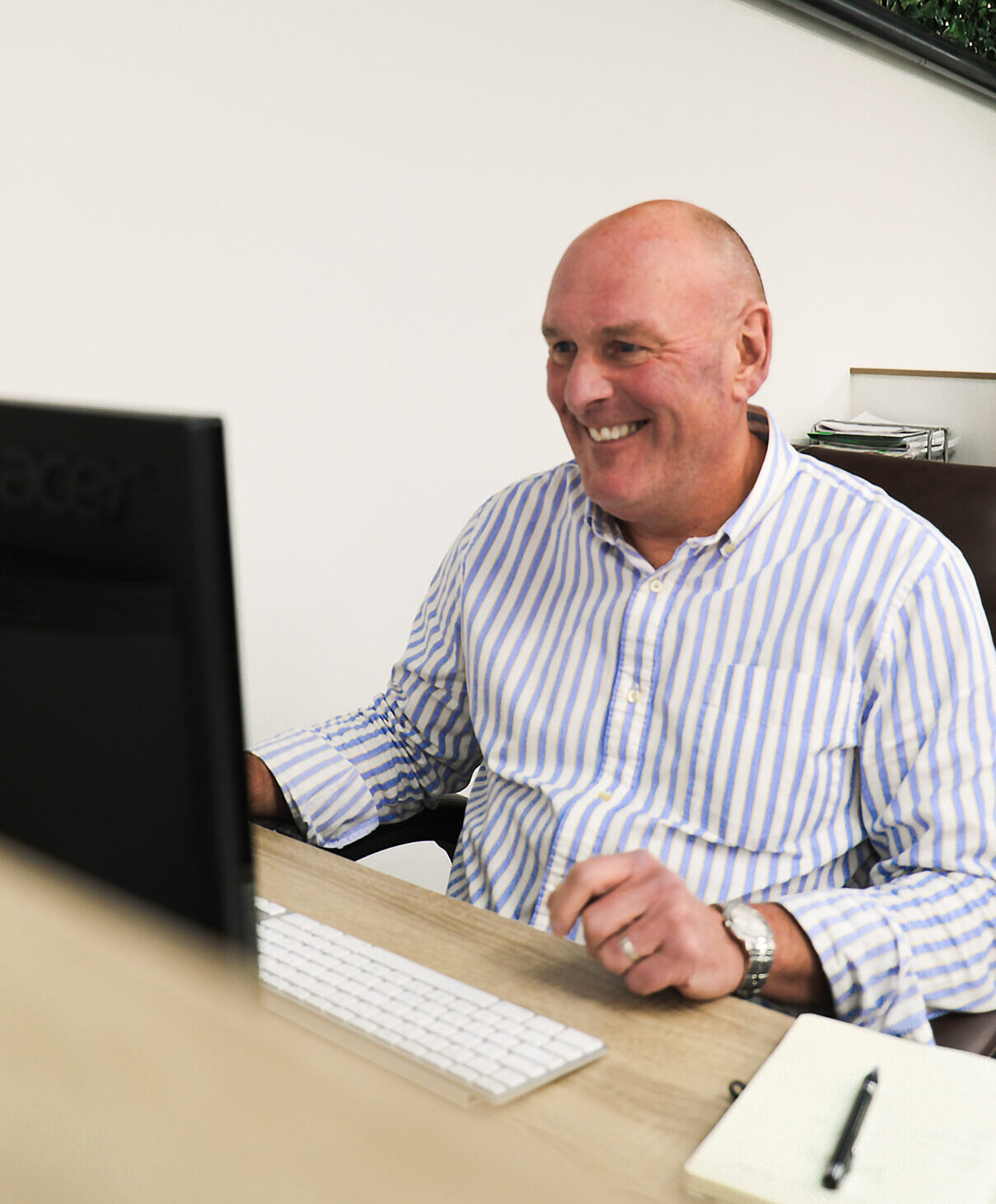
Nigel has been a journalist since the days of typewriters (not even electric typewriters)! He has edited several weekly newspapers across Greater Manchester, been the editor-in-chief of several more and edited a daily newspaper in Northern Ireland. He came home to work on the former Greater Manchester regional TV station Channel M. Having dropped the […]
Find out more about usMore from our blog
Creativity – the intrinsic particle of business success
Why creativity is top of the effectiveness charts
We often describe our design team as Cornerstone’s creative cog – somehow the words creative and design seem to go together.
But when you stop to consider, the word creative has connotations for every single fibre of a business. Without creativity a business stagnates, without innovation it can’t grow.
For example, designing the most cost-effective, efficient method of despatching your product is just as crucial as the creativity that went into the packaging design.
This study of why creativity is fundamental to the success and effectiveness of any business is beautifully summed up by Sarah, ironically our Head of Creative!
She says: “Everyone has the capacity for creative thinking, and we can’t just assume that being creative only applies to certain job titles or job roles. When you acknowledge this and encourage EVERYONE to embrace creative thinking your business discovers endless possibilities.
“It’s not just about the end goal – whether that’s a piece of graphic design work, or a creative piece of writing. Creativity can help people problem solve, it can spark innovation and growth, it can generate new ideas, positive change, create an open environment for sharing new ideas and ultimately increase profitability – all incredibly important in the tough economic climate.”
Creativity – an in-demand skill (according to Harvard)
Sarah’s viewpoint is mirrored by the world-renowned Harvard Business School no less, whose insight into creativity encapsulates where the drive for creative thinking is most prolific, and therefore significant in the world we live in.
According to Harvard Business School, creativity is an in-demand skill, and these are the industries/sectors employing the most people with what it describes as design thinking skills:
If you’re wondering what design thinking means, this is how Harvard describes it: “While creativity is highly important in business, it’s an abstract process that works best with a concrete structure. This is where design thinking comes into play.
“Design thinking – a concept gaining popularity in the business world – is a solutions-based process that ventures between the concrete and abstract. Creativity and innovation are key to the design thinking process.”
In Harvard Business School Dean Srikant Datar’s course Design Thinking and Innovation, the process is broken down into four iterative stages:
Clarify | Ideate | Develop | Implement
IMAGE (Courtesy of Harvard Business School Online)
Reap the rewards of creativity
When Cornerstone celebrated its 15th anniversary, we captured our story in 15 significant milestones. Whilst that was creative in itself, it paints a picture of a business that has grown, innovated, generated new ideas and products and increased turnover and profitability – coming through the pandemic with strength and compassion and prospering in tough economic times in the process.
We are a full-service agency, which means we provide every discipline of marketing – design, digital, PR, print and signage, strategy and web – each and every one underpinned by the creative thinking so eloquently described by Sarah earlier in this blog. Our ability to develop new and/or imaginative ideas and turn them into reality is innate in every one of us.
As our milestones illustrate, it’s stood us in good stead in the past and continues to do so as we look to make even more landmarks.
That’s why your business needs creativity. It’s what sets you apart from the competition, and it’s what helps you succeed in a crowded marketplace. But creativity can be difficult to nurture and develop – especially when you’re busy running your business. So, if you’re reading this, you know where to find us!
Why you should foster a creative environment
A place where people can think outside the box and be innovative, will encourage your team, or teams, to come up with new and better ways of doing things. This can help reduce costs, save time, and create a more efficient workplace, which usually equates to a healthier bottom line.
The ability to quickly assess new situations and develop strategies is an essential skill in today’s business world. Ever expanding technology makes it even more necessary to be creative as digital environments constantly change.
It’s simple to say foster a creative environment, but how do you do that?
We’ve found that creating a positive work environment where the team feels comfortable sharing their ideas and pushing the boundaries is a great place to start. Practice what you preach, and you’ll open the door to new ideas. It has often been said a work environment reflects its owner.CS BLOGS
Here are some more ideas:
- Reward creativity by recognising and praising employees who come up with innovative ideas and/or good work.
- Brainstorm and learn together – this can be done in a meeting, during a learning lunch, and even socially after work.
- Create diverse teams – don’t forget that opposites can attract.
- Encourage flexible work arrangements – they can help employees feel more comfortable and productive.
Nurturing a creative mindset
Creativity has always been a valuable currency for businesses but arguably the pandemic added to its worth. It created a new world, one where the need for flexibility, for new ways of working, for thinking outside the old world boundaries could mean the difference between sink or swim. The demand for that kind of mindset has stayed with us.
A creative mindset is what helps businesses overcome challenges and succeed in this day and age. By thinking outside of the box, you can discover innovative solutions to the obstacles you face and prosper in the business world, regardless of the situation.
Easier said than done sometimes. How do you nurture a creative mindset?
As we’re talking about being creative, Bay Atlantic University in Washington DC has some good and unusual ideas:
- Take a walk – According to a study based on the Kaplan theory, nature can enhance creative ways of thinking. This theory suggests that natural environments help recharge directed attention that is required when analysing and developing ideas. Research also suggests people are more creative when they’re standing rather than sitting down.
- Broaden your knowledge – every idea you have is a combination of concepts that you already know. That is why the more knowledge you have, the greater your potential of generating unique ideas.
- Analyse and develop – your first idea might not be that great, but it could develop and get better.
- Be bored – a study by the Journal of Experimental Social Psychology suggested that participants who felt bored performed better on creativity tests than the ones feeling distressed or relaxed. Give yourself the space to be creative, especially around technology.
Go on, give it a go!
Those of a certain age will recall the Sinclair C5 electric buggy (Google it!) for getting about town. That same generation will remember the first mobile phone. Some ideas work, some don’t – but remember, some of the greatest inventions ever made were once just ideas. And ideas are born from creativity.
If you are interested in harnessing the experience, expertise, professionalism and creativity of Cornerstone DM to benefit your business or organisation, get in touch
Get in touch with usThe power of PR – the secret weapon to brand presence
PR is just about writing press releases, right?
Wrong. Public relations are a multi-faceted discipline which underpins every aspect of marketing and brand or business communication.
Think of PR and marketing as an onion. Pull away a layer of marketing, you’ll find a layer of PR right there underneath. If that makes you cry a little because you haven’t valued, implemented and appreciated PR enough, do read on. And keep the tissues handy.
While the campaigns are rolling and the strategy is playing out, PR is there; drip feeding presence, earning reputation, building relationships and influencing opinion and behaviour. It works hard. Very hard.
While marketing is traditionally a one-way push to promote a product, brand or service, PR is very much a two-way conversation, skilfully storytelling and evoking emotion, reaction and response.
Before we delve into exactly how it achieves all those impressive attributes, let’s look at why it’s so essential / amazing.
Why is PR so important for brands, businesses and organisations?
Every organisation from global corporations to SMEs, relies on reputation and presence in order to succeed and indeed survive.
Everything said, done and written has a sliding scale of good or bad impact.
Clearly, we’re striving for good PR to raise awareness and build positive relationships with the target audience to achieve the end goals – earning brand trust, increasing presence and commercial gain.
Clearly bad PR is what we’re aiming to avoid and if it does happen it’s usually the result of bad planning, thoughtless communication or poor internal comms. Not always, but more often than not.
In those situations, crisis management kicks in and despite being well drilled to handle it, it’s what every PR team dreads.
Some of the most touted and quite frankly devastating bad PR of all time includes Gerald Ratner turning his multi-million-pound family jewellers empire to ashes in seconds in 1992 with a throwaway remark about its products being “total crap”.
Commenting on the fallout in the aftermath of an oil rig explosion in 2010 which killed 11 workers and caused ‘the worst environmental disaster in US history’, BP CEO Tony Hayward caused absolute outrage when he commented: “I just want my life back”.
That on top of a series of other PR gaffs amounted to plummeting BP stock prices.
While these are monumental examples, bad PR can seriously damage a brand or business of any size.
They certainly highlight the power of PR – just not in the way you’d like to brandish that power.
Negative or bad PR can be hugely detrimental, which is why it pays to take it extremely seriously to ensure it is planned, well executed and on point.
The importance of PR
While it’s POWERFUL, PR should also be EMPOWERING for a brand or business and that takes strategic skill, know-how and insight.
Take these PR campaigns – a strategic roll out of activities designed to give maximum and sustainable publicity.
Our first example seems a surprising one.
Surely Spotify’s annual Wrapped campaign, which offers subscribers a deep dive into their listening habits throughout the year, is simply another marketing ploy?
It’s actually a very clever, enduring PR tactic which is not only creatively conceived in the graphics and copywriting stakes, but also highly personal and sharable.
It’s outside-the-box PR thinking which is emotive – provoking music memories for its users – and has become a pre-Christmas tradition which goes viral every year.
It also has its rivals sobbing into their mince pies and mulled wine (sorry Apple and YouTube).
Skincare brand Dove’s Real Beauty and #TheSelfieTalk are textbook PR campaigns.
Based around the beauty industry’s impact on self-esteem and body image, it challenges the need to look perfect and champions real women’s bodies and natural beauty instead.
This has gained the brand an army of fans and followers, joined in the solidarity of empowerment, self-confidence and positivity about the way they look.
How to harness the power of PR
Effective PR relies heavily on alignment between marketing and communications teams.
Although that seems to be trickier to manage in-house, for full service marketing agencies like Cornerstone it’s all part of the natural process.
With brand image and reputation more essential than ever due to highly competitive markets and a shift in consumer expectations, that alignment is critical.
Today’s audiences demand credibility, relevancy and trust and that’s where PR takes centre stage.
Whether it’s press releases, social media, blog posts, or well-written advertising messaging, PR is the conversational glue that holds marketing strategies and campaigns together.
It sets the right tone and instils credibility and trust that advertising alone can’t achieve.
So, ultimately what are we saying?
We’re saying for a brand and business to grow and succeed it has to rely on reputation.
Reputation has to be earned, fostered and managed and PR is one of the most effective ways of doing it.
Carefully aligned with marketing strategies it has the power to reach, the power to influence and the power to change.
Get in touch if you want to find out more about our PR services.
Our PR servicesMeet our raft of senior appointments as another year of record turnover beckons
We have made a raft of senior appointments to support our growth as we looks towards another year of record turnover.
After celebrating our 15th anniversary in January, we’re forecasting to surpass £2m turnover this year thanks to new client contract wins locally, regionally, nationally and internationally, with projects across all departments.
Two of the most senior appointments have been made in the web department to bolster a burgeoning client roster.
Technical Lead, Phil Owen
The first is Technical Lead Phil Owen, who joins Cornerstone full-time after several years of working with the agency as a contractor. He specialises in WordPress web builds and has a wealth of experience in UI (user interface) and all-round web technology. He is refining processes and improving efficiency to leverage the best technical workflows to benefit the agency’s commercial goals.
Senior Developer, Steve Perry
He is joined by Senior Developer Steve Perry, another hire who knows Cornerstone well after several spells freelancing for the firm. He specialises in Laravel web applications and cyber security having gained a National Cyber Security Centre-certified master’s degree in advanced security and digital forensics at Edinburgh Napier University, from where he graduated with a distinction in 2021.
Earlier this year he published a research paper in the Journal of Digital Forensics, Security and Law, which contributes important research on wearable technologies.
Cornerstone founder and MD, David Wadsworth says:
“The agency turnover has seen consistent growth of well over 30% year on year for the last five years, with last year setting a new record at 50%. That’s been a lot of work to manage, and our core focus on quality and service in everything we do has been supported by the appointment of some really key hires within the business.
“Our new team members are all seniors, with many years of experience in our industry, which means we can continue to move the agency forward quickly, deliver quality for our clients and also support junior team members’ training and development via some of the best the industry has to offer.”
Junior Developer, Hannah Jones
Stepping up to full-time in the web team is former Level 3 Software Development Technician apprentice Hannah Jones, who has been made a Junior Developer after passing her apprenticeship with a distinction. Fellow team member Joe Durrans continues to work part-time while studying Computer Science at Manchester Metropolitan University.
Business Development Manager, Jamie Smith
Joining Cornerstone in a newly created role is Business Development Manager Jamie Smith, a former Sales and Marketing Manager with Oldham Community Leisure (OCL). Previously, he’s worked as a membership consultant and then a sales manager with Virgin Active before sales manager roles at Nuffield Health and The Village. He then spent four years in the recruitment industry before a return to the leisure sector at OCL.
The other new recruits are:
- Account Manager Abigail Tomlinson – who studied International Fashion Marketing at Manchester Metropolitan University and has also worked in PR, which she combined with studying for a master’s degree in creative advertising.
- Senior Digital Marketer Cara Hernon – who has worked in marketing for the best part of a decade, mostly in the health, wellness and leisure sector.
- Office Administrator Casey Wild – who comes from an operational role in the mechanical engineering sector, overseeing teams of engineers working on a wide range of projects.
- Josh Tomlinson – who joins the web team as Project Manager covering a maternity leave .
MD David, who first launched Cornerstone from the attic of his parents’ home, adds: “We’re seeing many larger national and international brands moving to our agency thanks to the high level of service and focus on quality we’ve become renowned for, so it’s a great time for all these new team members to be joining our growing agency.”

Nigel has been a journalist since the days of typewriters (not even electric typewriters)! He has edited several weekly newspapers across Greater Manchester, been the editor-in-chief of several more and edited a daily newspaper in Northern Ireland. He came home to work on the former Greater Manchester regional TV station Channel M. Having dropped the […]
Find out more about usLearn more about us
Take one ambitious young man, give him an opportunity and what do you create? Read on!
There’s one word in particular that’s synonymous with Cornerstone – and that’s quality.
Quality of the work we produce, and of the people who produce it.
It’s also one of the first words that comes out of the mouth of our Print Room Manager, Sam Casey, when we sit down with him to chronicle his Cornerstone career journey to share with other jobseekers interested in working for us.
This was his reply when we asked Sam what made Cornerstone different to any of the previous places he’s worked: “The quality of work and the people was obvious straight away. The workplace was much tidier, and the jobs were more well organised.
“Everything we do is made from top quality materials and is quality checked when it comes in and before it goes out. It’s the atmosphere too. Everybody is professional, sociable and friendly, and it all comes back to being excellent and giving the customers what they want.”
Quality (sorry, we couldn’t resist!) should be your mantra if you’d like to join Sam and the Cornerstone team.
Seizing a big opportunity to develop a career
Sam joined Cornerstone four years ago, having worked in the signage industry since leaving college, starting out making number plates in his uncle’s graphics business before moving to a signage company in Stockport, where he found himself mainly working on installations but wanting to do more.
As a local lad to our base in Lees, near Oldham in Greater Manchester, it was the location that Sam first spotted when we advertised for a print room and signage operative. On closer inspection, he realised a fantastic opportunity was staring him in the face.
Sam takes up the story: “Yes, the job was only round the corner, but I could see there was a big opportunity to grow in it. Back then, we only had one person in the print room, and the job was a lot more advanced than I was used to.
“The learning curve has been steep. I’ve learnt 100 per cent more here than anywhere else I’ve worked – developing client relationships, learning new printing techniques and systems, quoting for jobs and some Cornerstone business development work, which has been going well. I’ve gone from doing one bit of a job to doing the whole thing.
“You’re part of a bigger team as well. Everybody is friendly and supportive, and you get to understand their jobs and they understand mine, so it makes it a streamlined process seeing a job through from start to finish.”
A proud track record of developing talent
Sam is one of several products of Cornerstone’s proud track record of developing talent and providing opportunities for employees to progress their careers, an ethos embedded by our founder and MD David Wadsworth.
“We’ve built a team of talented specialists by investing heavily in their training and development, helping them to build a career within our organisation that satisfies their ambitions for personal growth and development, whilst helping to deliver ever improving results and client satisfaction,” says David.
“It takes a lot of graft to get the right people and the right personalities with the right ethics. It’s been a huge focus of mine over the years, and it’s been a focus of how I’ve trained our management team to go and recruit people in the same way. Just anyone isn’t who I want, and it’s not the way I’ve wanted to build the business.”
Working at Cornerstone – the word according to Sam!
We asked Sam to share more of his experiences of working at Cornerstone. Here they are:
CS: How have you seen the company evolve?
Sam: “Since I started, it’s grown about 50%. When I started, there were 15 members of staff, and now we have 30. The great thing is that we’ve maintained the same culture even though we’ve grown so much. Everybody is just as friendly, supportive and, obviously, professional. And it’s not just me anymore, I’ve been joined by Steve in the print room – so that means I’ve worked with him for 10 years now after getting to know him at my previous place at Stockport!”
CS: What excites you about the future?
Sam: “The different challenges this job throws up. New clients mean new challenges and a lot of bespoke work. There are some techniques we’ve not used yet, such as a burnt wood, ranch-style effect, that we’re hoping to do soon for a client we’re talking to. There’s a rustic-effect rust signage technique that we’ve been looking at for a client too, so I’m hoping we can give that a go. I’ve seen it out and about and I’m looking forward to doing it. I think some clients will like it when they see it.”
CS: What benefits have you seen/does the company provide?
Sam: “The most obvious benefit is that I’ve been given the chance to develop in my job and grow it into what it is today, Print Room Manager. But I’d also say we’re pretty well paid, we get help with medical expenses, the holidays are decent, especially at Christmas, and there’s an overall caring attitude towards everyone who works here. The flexible working, for example, gives people the best work/life balance.”
CS: What’s the leadership team like and the dynamic across departments?
Sam: “The leadership is good, there’s always someone you can ask for help and advice. If it’s not David, then someone else will help you. That’s helped by the dynamics across the departments, we all know each other well. I’ve grown to understand what they do, and they now understand my job too, so say for example, I’m dealing with the account managers and the designers, it means jobs get done quickly and smoothly.”
CS: How do you find working in a full-service agency, as opposed to in-house or single service?
Sam: “It’s bigger and there’s more people doing different jobs, whereas where I worked before we were just doing signage, although there were designers and account managers but not as many. The good thing about being part of a full-service agency is the number of people you can ask for help and advice; it really improves the workflow and takes away any hassle.”
CS: What are the clients like?
Sam: “We build very good relationships with our clients. By getting to know them well we have good communication and that helps to get the job done to everybody’s satisfaction. That’s another thing about being a full-service agency, a client might come to us for signage but then as the relationship develops they might want different things from us, such as marketing, website work, advertising, PR and such like. Sometimes, we’re the first connection with Cornerstone and that can lead to much more, so you always have to have that in mind.”
CS: What’s the one standout thing you’d say to anyone considering working at Cornerstone?
Sam: “It’s quality again. We work with the best materials, there are no imperfections, and everything is checked, and checked and checked. We get sign off from the client before and after their job goes into production, so everything is absolutely nailed down.”
CS: What’s been your biggest challenge so far?
Sam: “It was a huge sign at Waterside Leisure Club in Cheadle, it’s the biggest installation I’ve ever worked on. We worked closely with our designers on the creative, conducted the site survey, and made sure all the details were of the correct specifications for the install.
“The sign was so big, it had to be lifted off the delivery truck by a crane, so we had to create concrete anchor points, so it was safe and secure to offload it. It was backlit and part timber in construction too, so we had to prepare all the electrical connections. It was mainly installation but it’s the biggest job I’ve worked on.”
CS: What’s your favourite piece of work?
Sam: “That’s the Waterside installation – it was huge.”
CS: What do social events look like at Cornerstone?
Sam: “We work hard but we like a good time as well. The two standouts are the team building and summer barbecue day every year, and the Christmas party. Last year’s Christmas party had a tongue-in-cheek Oscar presentations, buffet, live band and cocktail bar – it was one of the best yet and everything was free. There’s loads of other stuff going on too, like trips in to Manchester, going for a curry night, and quiz and games nights in the office with free food. We like a good laugh.”
CS: If you could only say 10 words about the team, what would they be?
Sam: (Long pause for head scratching!) “Professional, friendly and well balanced, by that I mean everyone has a good work/home life balance. Is that 10 words?”
CS: Let’s try again! If you could only say 10 words about the agency, what would they be?
Sam: “Flexible, professional, friendly, quality, hardworking, we enjoy what we do.”
CS: You nailed it that time, Sam!
If Sam’s story has whetted your appetite for working somewhere very special, get in touch with your CV. If you have the qualities we’re looking for, it might just be the best move you ever make!
Get in touch

Nigel has been a journalist since the days of typewriters (not even electric typewriters)! He has edited several weekly newspapers across Greater Manchester, been the editor-in-chief of several more and edited a daily newspaper in Northern Ireland. He came home to work on the former Greater Manchester regional TV station Channel M. Having dropped the […]
Find out more about usMore from the blog
From Account Exec to Head of Digital: What I’ve Learnt from Six Years at Cornerstone
When I left university with an English degree and a summer of European travel ahead of me, I had no clue what I wanted from a career. I remember a family friend asking me the question and my response was something along the lines of:
“To help take a small business to the next level, to get its name out there and watch it thrive knowing I had a hand in that.”
Marketing. Marketing was the word I was looking for in that moment.

I then spent a year working two jobs as a remote marketing coordinator for a B2B start-up and PR exec for an education marketing agency, working to achieve my Google Squared qualification, discovering a growing interest for digital, and, honestly, feeling incredibly isolated and disengaged before a recruiter reached out to me with an account exec opportunity at an agency in Oldham.
I joined Cornerstone when there were just eight of us on the team, and when the opportunity to take on more digital responsibilities arose, I jumped at the chance. Delivering full-service campaigns that excelled, coupled with David’s tenacity for growing our client base, it wasn’t long before the digital and wider agency team was expanding.
Growing from a team of 8 to 30+ in the last six years hasn’t been easy and there have definitely been key learnings over the years which I’d like to share here…
Challenges are easy to overcome when your team has your back
You’ll hear me say it time and time again, but our people are genuinely one of the best things about Cornerstone. Creating an environment in which people feel comfortable enough to give honest feedback means that when challenges arise, you have a team that you’re fully confident in and who are just as trusting in you.
We like to say that we get shit done, taking a proactive approach to any and all things that are thrown at us on both a client-side and internally too. We wouldn’t be able to say that with confidence if we didn’t trust in our team and if they didn’t trust in each other.
Making sure we continue to grow our team with honest and reliable people is pivotal in knowing that we can handle whatever the next curveball is.
Management and leadership are very different but equally important
When we formed our Senior Management Team (SMT) in 2020, it was the beginning of a new team structure for Cornerstone adding a layer of managers and leaders between our Managing Director and the rest of the team (though I still think you’d be hard pressed to find an MD that’s as available to the entire team as David is)!
Embarking on this new role, for me, was a steep learning curve, understanding that every team member benefits from different levels of leadership and management. It also allowed me to understand where I could improve as a leader and manager. I always felt I was pretty good at the leadership side (mentoring, leading by example etc.) but the management side was a whole different ball game.
We’ve since invested heavily in training and developing our internal processes to ensure that each department head is fully supported to lead their team to success, and that the success is shared and felt by each individual.
Our client base matters
What’s an agency without its clients?
Obviously, they’re the reason we’re all here, but we want to believe in that reason too.
We make sure that every client we work with aligns with our own ethos and morals, as well as providing exciting and enjoyable accounts for the team to spend their days working alongside.
You’ll often hear the team say no two days are ever the same and they’re right thanks to our client base spanning leisure, pharma, eCommerce, health, public and private sectors.
Culture is what you do, not what you say
‘Culture’ is a word that seems to get wheeled out more and more in every recruitment campaign I see across all industries nowadays. Many businesses seem to have identified it as some sort of buzzword that they think equates to a day off on your birthday or meeting bare minimum salary requirements for the role, when it’s in fact the absolute key to employee wellbeing if actually delivered on.
At Cornerstone it’s constantly at the top of our agenda, ensuring we’re adapting day-to-day agency life and long-term strategies to genuinely create a culture that helps the team thrive. It’s not just the annual bonuses and salaries benchmarked on UK averages. It’s the private healthcare, flexible working, funded social events, in-house gym, team building days out of the office, training budgets, learning lunches, monthly nail and beauty appointments, quarterly car valeting, regular employee surveying, one-to-ones, mentoring, employee rewards, celebrating each other’s wins on a daily basis and approaching a collaborative work environment in an encouraging way.
As part of this blog, David also asked me:
“If you could only say 10 words about the team, what would they be?”
- Hard-working
- Grounded
- Friendly
- Ethical
- Driven
- Fun
- Reliable
- Intelligent
- Supportive
- Trustworthy
“If you could only say 10 words about the agency, what would they be?”
- Hard-working
- Grounded
- Friendly
- Ethical
- Driven
- Fun
- Reliable
- Intelligent
- Supportive
- Trustworthy
Yes, those two lists are exactly the same. Because our team make our agency what it is. Without them, Cornerstone wouldn’t be even a shadow of what it is today.
If this has you in any way interested in working at Cornerstone, make sure you check out our careers page. Even if there’s nothing open in your specialism, you can sign up to be alerted as soon as we’re next recruiting.

Jess joined Cornerstone as an account executive in January 2017 following freelance roles within marketing and PR fields. Exploring her passion for all thing digital, Jess embarked on several training courses and became Cornerstone’s dedicated digital marketer within 12 months of joining the Cornerstone team. Jess gets involved in all digital work at Cornerstone including […]
Find out more about usMore from the blog
24 Crucial Facts About Using Threads That You Need To Know
Threads is a new app developed by Instagram which has been designed to be a text-based social media platform, built for users to share text and join public conversations.
The Threads app, released on 6th July 2023, allows users to post short text-based messages, much like it’s competitor Twitter. Twitter has been a prominent social media platform for over a decade, offering a space for users to express their thoughts and engage in conversations with a global audience through short form text.
Instagram says ‘Our vision with Threads is to take what Instagram does best and expand that to text, creating a positive and creative space to express your ideas’.
As Threads begins to find its place in the social media landscape, we’ve explored 25 things you need to know about Threads, things you should consider within your social media strategy, and how to harness the growth opportunities it presents for your.
An introduction to Threads
- What is Threads, and what is the Threads app for?
- How do you set up a Threads account?
- How does Threads work?
- How to post on Threads
How to use Threads
- Threads character length
- Hashtags on Threads
- How to react on Threads
- Using multiple accounts on Threads
- What can posts on Threads include?
- Threads search function
- Who can use Threads?
Instagram & Threads
- Do you need an Instagram account for Threads? Is Threads linked to Instagram?
- What data is used from your Instagram account?
- Importing Instagram followers to Threads
- Deleting your Threads account
Threads content and safety
How popular is Threads?
- Time taken for social channels to reach 1 million users
- Who was the first to reach 1 million followers on Threads?
- Most followed Thread accounts
- Thread language
What to expect from Threads in the future
An introduction to Threads
1. What is Threads, and what is the Threads app for?
Threads, an Instagram-associated new app from Meta, the parent company of Facebook, Instagram and WhatsApp, and Meta’s text-based rival for Twitter.
The Threads app is built for sharing short-form text and uses Instagram’s existing safety and user controls. It allows you to connect with friends and those with whom you share interests, get real-time updates and engage in discussions.
2. How do you set up a Threads account?
To set up a Threads account, you’ll need to download the “Threads, an Instagram app” from the App Store or the Google Play Store and install.
You will then need to use your Instagram account to log in. This allows your Instagram username and verification to follow you over to Threads, however you can customise your profile for Threads separately.
Threads will ask you to confirm your username, bio, link and profile information the first time you log in, which you can import from Instagram. You can choose your privacy options, allowing you to choose between a public or private profile.
You’ll then be asked to choose some accounts to follow before you click Join Threads and you are ready to start threading. You can import your following directly from your Instagram account, too.
3. How does Threads work?
Threads is an Instagram app and social media platform where you can post short pieces of text (threads), reply and engage in conversations with others and follow friends, family or profiles you are interested in.
Any thread you post will appear on your profile and in feed. You can choose who can interact with your threads through your privacy settings.
4. How to post on Threads
- To start a new thread, click tap the icon centred at the bottom of your app.
- Draft your thread, if you’d like to include photo or video, click the to attach up to 10 items, and Done (Android) or Add (iPhone) in the top right.
- To add to your thread, tap Add to thread, if you exceed the character limit another thread will be automatically generated.
- You can then choose who can reply before you post by tapping Anyone can reply in the bottom left.
- Then tap Post to publish your thread.
How to use threads
The Threads app is easy to use, and here’s what you need to know when getting started.
5. Threads character length
Thread posts can be up to 500 characters long and include links, photos and videos (up to 5 minutes in length) and can be easily shared or reposted to your Instagram story.
6. Hashtags on threads
Hashtags are used to help make search easier on many social media platforms by placing a hashtag symbol(#) before keywords or phrases. They are used on many social platforms including Facebook, Instagram and LinkedIn, and popularised on Twitter.
When used in the Threads app appear in the feed as normal text and they are not interactive in the same way as on other social media channels.
At present Threads do not use hashtags, nor is there a function to search specific content or posts by hashtag. However, there is speculation that Threads will have hashtags in the future, as Instagram announced they will soon add a number of new features to help with discovery and search on the platform, making it easier to follow trends.
Post by @threadsappView on Threads
7. How to react on Threads
There are a number of ways you can react on threads, which include:
- Liking – clicking the heart icon to like a post or comment on a thread
- Commenting – you can comment on threads, known as a reply and choose who can respond to you when in your draft and after you post.
- Reposting – you can repost or quote a thread.
- Sharing – you can share by adding to your Instagram story or posting to your Threads feed.
8. Using multiple accounts on Threads
Threads does give you the option to have multiple accounts, however to navigate between multiple accounts users are required to log out and initiate a switch from the main login screen.
For people who have multiple accounts, such as social media marketers, the switch between multiple accounts is not as seamless as it is on Instagram. The switch will require a few taps to log in and out of different accounts, here’s how you do it:
- First make sure you have Threads account created for each of your accounts.
- Navigate to your profile page and click on the hamburger menu located at the top-right corner to access the settings.
- Within the settings, scroll down to the bottom of the page.
- Look for the option to log out and select it.
- A prompt will appear, asking you to confirm the logout from your current profile.
- After confirming, you will be redirected to the home page.
- Below the home page, you will find the option to log in with your primary profile.
- If you have multiple profiles added, click on the option to switch profiles and choose the desired profile for logging in.
9. What can posts on Threads include? –
On the Threads app you can include text and links alongside up to 10 photos or videos up to 5 minutes in length.
10. Threads search function
Since its launch, the Threads app has only allowed users to search for Threads accounts by username, unlike search functions we see on social media platforms like Twitter, Instagram and Facebook which allow you to search key words and phrases, helping you to find relevant information and trending topics.
However, Instagram shared details of future developments for Threads, which included new features to help you find threads and creators you’re interested in and improvements to the search function that will make it easier to follow topics and trends as part of their Threads launch announcement.
11. Who can use Threads?
Threads was rolled out on Thursday 6th July 2023 to 100 countries, available only as an app on iOS and Android. Threads is not yet available in the European Union (EU), it’s release was postponed in the EU amid regulatory concerns about how the app will use personal data and safeguard user privacy, infringing on the Digital Markets Act, which regulates the sharing of user data across multiple platforms.
The app is also not available in Iran and is blocked in China.
Post by @threadsappView on Threads
Users need to be at 12+ to create a Threads account. Meta have shared that anyone who sets up an account and are under 16 (or under 18 in some countries) will have their accounts defaulted to a private profile when they join Threads.
Instagram & Threads
12. Do you need an Instagram account for Threads? Is Threads linked to Instagram?
To create a Thread account, currently you do need to have a linked Instagram account. If you want to access Threads, you will have to sign up for Instagram first.
13. What data is used from your Instagram account?
Meta uses some of the data from your Instagram account to power your profile on the Threads App. When you create a profile on Threads, it becomes connected to the Instagram account you logged in with. This enables Meta to import your profile information, personalise your feed, and ensure your safety on both apps. Threads may also use Instagram data to personalise and enhance your experience on Instagram while promoting the safety and integrity of their services.
Data from your Instagram account which is used for Threads can include:
- Your Instagram login information
- Your Instagram account ID
- Your Instagram name and username
- Your Instagram profile information such as your profile picture, bio and links
- Your Instagram followers
- Accounts you follow on Instagram
- Your age on Instagram
14. Importing Instagram followers to Threads
Currently the Threads app does not allow you to import your Instagram followers to Threads. It does however offer your followers the option to follow you when they join Threads, offering them the option to follow all or manually select the ones you want to follow.
15. Deleting your Threads account
You can delete your Threads account, however you can’t delete your Threads account without also deleting your Instagram account currently. The Threads app does provide an option to deactivate your Threads account which will allow you to keep your Instagram and reactivate your Threads account whenever you log back into the app in future.
To deactivate your account by accessing your profile and clicking the two lines in the top-right corner, then clicking Account and then clicking Deactivate profile, the Thread app will then ask you to confirm you want to deactivate your profile, which will temporarily hide your Threads account and your content until you decide to reactivate it.
The link between your Instagram and Threads account currently means if you delete your Threads account you will also be deleting your Instagram account. Head of Instagram, Adam Mosseri has provided an update and said that Meta is “looking into a way to delete your Threads account separately.”
Post by @mosseriView on Threads
You can deactivate your Threads account, which will hide your profile and content from other users. You can reverse this by reactivating your Threads account at any time by logging back in.
Threads content and safety
16. Safety features
The Threads app uses Instagram’s existing suite of safety and user controls, enforcing Instagram’s Community Guidelines on content and interactions in the app.
Threads, allows you to use safety features like blocking, reporting and hiding. Additional privacy settings have been created to help users stay safe on the app, this includes:
- Profile settings such as “Public profile” to allow anyone to interact with you, or “Private profile” to only allow interaction from people that follow you.
- Minors will have their accounts defaulted into a private profile when they join Threads.
- Hidden words which is a feature that allows you to hide replies or messages for specific words on Threads and Instagram, or you can add custom words to the list if you’re getting harassed.
Post by @mosseriView on Threads
17. What we know about the Threads algorithm (so far)
Meta haven’t shared too much about the Threads algorithm and how it decides which content we see just yet. What we do know has been shared by Head of Instagram, Adam Mosseri that the algorithm does not heavily rely on ranking posts but recommends posts from random accounts, the ones you do not follow. He notes that it is important for a new app, as users need to follow enough people to get the algorithm working.
Post by @threadsappView on Threads
Currently on the Threads app, you can see content from accounts that you follow, as well as accounts you don’t. Threads also does not currently feature a chronological feed option like Facebook and Instagram, however, Mosseri shared that it is a feature that they will be bringing to Threads.
How popular is Threads?
Within the first few days of Threads being launched it’s safe to say that Threads has been a hit with over 30+ million users in the first day alone.
Post by @zuckView on Threads
The timeline of signups is as follows:
- 1 million users in 30 minutes
- 2 million users in the first 2 hours
- 5 million users in the first 4 hours
- 10 million sign ups in 7 hours
- 30 million sign ups after 24 hours
In fact, Threads has been so popular that it has been one of the quickest social media platforms to reach 1 million users:
18. Time taken to reach 1 million users:
- Netflix – 3.5 years
- Twitter – 2 years
- Facebook 10 months
- Spotify – 5 months
- Instagram – 2.5 months
- ChatGPT – 5 days
- Threads – 30 minutes
Post by @zuckView on Threads
19. Who was the first to reach 1 million followers on Threads?
According to business insider, as of Thursday morning, the official Instagram account (@instagram) was the first account on Threads to reach 1M followers.
The first person to reach 1 million followers was Mr Beast (@mrbeast), reaching 1 million followers hours after launch, according to The Guinness World Records. Mark Zuckerberg (@zuck) reached 1 million followers 20 minutes later at 15:02PM.
20. Most followed Threads accounts
As of the second day after launch the top 10 most followed Threads accounts are:
| Rank | Username | Owner | Followers | Activity | Country |
|---|---|---|---|---|---|
| 1 | 4.6M | Social media platform | United States | ||
| 2 | @natgeo | National Geographic | 2.8M | Magazine | United States |
| 3 | @kimkardashian | Kim Kardashian | 2.7M | Television personality, model, and businesswoman | United States |
| 4 | @mrbeast | MrBeast | 2.7M | YouTube personality | United States |
| 5 | @shakira | Shakira | 2.2M | Musician | Colombia |
| 6 | @chrishemsworth | Chris Hemsworth | 2.1M | Actor | Australia |
| 7 | @willsmith | Will Smith | 2.1M | Actor | United States |
| 8 | @kyliejenner | Kylie Jenner | 2M | Television personality and businesswoman | United States |
| 9 | @9gag | 9GAG | 2M | Social media website | United States |
| 10 | @jlo | Jennifer Lopez | 2M | Musician and actress | United States |
What to expect from Threads in the future
Threads has had an explosive launch and a positive reception overall from it’s new users of the app. But what’s to come from the future of the app? Creators from the Thread app have hinted, along with speculations from users, of what’s to come in the future:
22. Compatibility of Threads with other apps
Threads are working towards compatibility with ActivityPub protocol established by W3C, which would make Threads interoperable with other apps that support the protocol, such as WordPress which are currently not possible on most social apps.
In their announcement, they shared that their vision is “that people using compatible apps will be able to follow and interact with people on Threads without having a Threads account, and vice versa, ushering in a new era of diverse and interconnected networks.”
23. Threads chronological timeline
Threads does not currently feature a chronological feed option, and shows content from people you follow and people you don’t alongside one another. However, head of Instagram, and one of the minds behind the creation of Threads – Adam Mosseri (@mosseri) shared that the chronological feed is something that they will be bringing to the app in the future.
Post by @mosseriView on Threads
24. Threads ALT text
The Threads app currently does not allow for alternative text (alt text) as an option for images or video on the app, which is crucial for accessibility. While screen readers are supported and AI-generated descriptions of images are enabled on the app, it doesn’t allow users to add alt text to their own images, as AI descriptions aren’t always accurate.
We do expect that this is an update which will be coming soon.
How to capitalise on the opportunity Threads presents for your business?
Capitalising on the growth opportunities presented by Threads, can be a useful strategy for businesses looking to enhance their brand visibility and engage with a wider audience.
While there is no guarantee that Threads will be a long-term success, it has seen exponential growth since its launch and continued investment in its development from Meta, Threads may prove to be a great opportunity for brands looking to grow their presence on social media.
Over the coming months, we’re likely to see a search function or the ability to see trends in Threads, which will give brands that have invested in their Threads social media strategy the opportunity to expand their reach.
Ask us how we can help you optimise your social strategy.
Let’s chat!
Our Senior Digital Marketer, Cara has worked in marketing for the best part of a decade, mostly in the health, wellness and leisure sector – in which Cornerstone has earned an excellent reputation via many word-of-mouth recommendations. Cara describes herself as very ‘data-driven’ and someone who loves optimising performance. She also loves delving into behavioural […]
Find out more about usMore from the blog
Social Media Marketing Updates For July 2023
From a ground-breaking AI bot to Meta making every social media marketer’s dream come true, here are the latest social media algorithm, tool, and feature updates for July 2023.
Instagram now allows up to 5 links in bio
Social media marketers asked, Meta finally listened!
Instagram users are now able to add up to 5 links to their Instagram bio.
Meta says that the motivation behind this change is to allow users to: “highlight what (they’re) passionate about, bring awareness to causes and more”.1
But does this mean the end for LinkTree and other linking tools? We don’t think so…
Although 5 links may be enough for some organisations, businesses who have a lot to offer and want to direct traffic to more than 5 webpages at a time are best sticking to linking tools for the time being.
Will we see an unlimited links in bio option from Instagram? Probably not. Will all social media marketers hope and pray for this? Most definitely.
LinkedIn testing suggested posts feature
LinkedIn Business have revealed they are testing a new Suggested Posts feature in grids after seeing a 2x increase in people engaging in posts sharing knowledge, ideas, and support2– which is something to note for your business’ future social media marketing strategies!
This will be an important new feature to consider when forming follower growth strategies, as it gives you extra opportunity to reach new audiences with engaging content.
The feature will look at what’s trending amongst professionals in your field and show users tailored conversations and content that will be relevant to them.
LinkedIn users are continuously looking for educations content on the platform that they can sink their teeth into and share their opinions on, and your business needs to satisfy this intent through informative content blogs (like this one), LinkedIn newsletters, infographics and more.
See how we can level up your LinkedIn strategy today by getting in touch!
Youtube stories are being removed
It’s time to say goodbye to YouTube Stories. It’s official: YouTube Stories will be removed on 26th June 2023, with live stories being permanently deleted 7 days after they were initially shared.
This move from YouTube is in a bid to compete with TikTok and Instagram Reels, which are continuously rising in popularity, by prioritising short-form content through YouTube Shorts – short-form videos that are up to 60 seconds long and appear in a Story format similar to Instagram, and Community Posts – a feature that allows you to connect with your audiences outside of video uploads, including polls, quizzes, GIFs, text, images and more.
If you want to be seen on YouTube, start utilising YouTube Shorts and Community Posts – if YouTube are prioritising these features, it’s likely that their algorithm is too and will BOOST your content!
Instagram’s image size update
You may have noticed that your Instagram feed looks a little different lately, and that’s due to Instagram changing the default size of all images and videos to a portrait size of 1080 x 1350.
What’s the difference? Instagram Feeds now look more visual and focus the user’s attention more to a singular post, increasing interactivity and engagement in the process. However, we need to be aware that the new cropping parameters may change how images appear in the Grid feed.
Snapchat AI BOT
Snapchat have recently launched an AI Bot that is powered by Chat GPT which has already ‘snapped’ up a lot of conversations – and not a lot of them positive.
Unlike Chat GPT, Snapchat’s conversational AI Bot does not aim to act as a search engine, rather its appeal is that you can talk to the AI every day alongside your friends to generate new discussion ideas, funny jokes, and more.
As our PR & Copywriter Nigel discussed in his latest blog on the power of ChatGPT, Chat GPT is great for conducting research and inspiring content ideas, but this new development sees its functionality being used for personal conversations with users through a Snapchat Bot. Users have reported it pulling their personal information such as IP addresses without explicit consent which would bring into question its privacy and GDPR compliance.
With Snapchat hosting a younger audience, parents have also raised concerns around the new AI feature which can be customised with a name and design a bespoke Bitmoji3 – the lines between AI and reality blurring more by the day!
This issue is likely something Snapchat could easily resolve, but with more digital users expecting privacy and control over their data, it’s heavily decreased the bot’s chances for success before it’s fully launched into digital orbit.
Cornerstone Chat Bot
One thing’s for certain – you can definitely trust the Cornerstone ChatBot!
Our Cornerstone ChatBot doesn’t use AI which gives you complete control to craft personal, relevant responses to user’s queries that align with brand tone. All of our chatbot responses are written by a human behind the computer screen and no personal data being collected unless it’s been provided by the user for a specific purpose through a GDPR compliant contact form.
Find out more about how our ChatBot services can improve your customer service and reduce call times by getting in touch with us today.
1 Meta Newsroom
2 Building LinkedIn
3 Snapchat’s New AI Bot is Already Raising Alarms Amongst Teens and Parents

Meet Digital Marketing Executive Madeline, Cornerstone’s FIRST-ever Degree Apprentice! Madeline (she insisted we use her Sunday name, the rest of the time she’s Maddy!) is making a well-considered choice to earn AND learn, as she’s currently working towards a Level 6 Digital Marketing Degree Qualification after achieving a Distinction in her Level 3 Digital Marketing […]
Find out more about usThe importance of storytelling within the leisure industry
What next for the public sector leisure industry? The story waiting to be told…
Here’s a true story, courtesy of Salford Community Leisure.
An 81-year-old lady attending a 24-week postural stability course at Wardley Community Centre was initially reliant on her walking stick.
On week one she managed six sit-to-stand exercises thanks to some real determination. This increased to 13 in week 12, and 15 by week 24.
Rightly proud and pleased with her achievement, she said to her instructor: “You haven’t noticed that I haven’t brought my stick for the last few weeks.” To which the instructor assured her they had noticed – and it had been a lot longer than just a few weeks! “Has it!?” she replied.
Why are we sharing that anecdote you might ask? Two reasons – and both are extremely and equally important for the future of public sector leisure.
The first is that the lady in question was feeling the benefit of exercise brought about by social prescribing – when health professionals refer patients to support in the community, in order to improve their health and wellbeing.
Secondly, by sharing her story, we are highlighting the benefits of social prescribing, thus bringing to life the excellent work and accomplishments being achieved not just in Salford, but in public sector leisure and community centres up and down the country.
If you didn’t know of the great work that goes on to benefit all ages, abilities, disabilities, health conditions and fitness levels day in, day out, you now have an inkling. That’s the power of storytelling, so imagine the level of awareness that could be achieved if more anecdotes and examples of excellent, life-enhancing work were shared by the operators of the 2,727* publicly owned leisure centres in the UK. (*Local Government Association)
Public sector leisure – the real story is in the telling
It’s no secret the leisure industry – public and private – is experiencing tough times due to the cost-of-living crisis and spiralling energy bills. At the moment, you are more likely to see and read about the financial implications for public swimming pools than you are about the water-based, Good Boost muscular skeletal programmes supporting those living with muscle and joint pain.
The lack of storytelling in the public sector leisure industry is actually undermining its unique selling point (USP) – that no one else is capable of providing the scope of wellness facilities and services currently being offered in our leisure centres and swimming pools.
So much so, that a leading figure in the leisure industry, Graeme Hinde, re-ignited the debate at the latest gathering of the LFX leisure industry networking group he founded, where more than 60 industry leaders were focused on the hugely relevant topic of ‘what next for leisure?’
Numerous topics and issues were covered but what came out loud and clear was that the sector has been, and still is, poor at telling the powerful stories that result from its work.
Telling those stories about how health and wellbeing is incorporated into day-to-day leisure and community centre activities can make a huge difference to the way public sector leisure is perceived. It prompted those LFX members present to make one simple pledge: to tell more success stories.
Taking the leisure storytelling debate public
Following the LFX event, Graeme took to the LinkedIn social media platform to share the debate, prompting more insightful observations, especially about the industry’s readiness to share success as a team triumph rather than it being seen as a ‘look at us, aren’t we great’ moment.
One reply, from Malcolm McPhail, CEO of KA Leisure, says: “(Graeme) I know the importance of this message and I hear you! However, are we as an industry ready to embrace these stories and use them as a Team Trust approach, demonstrating the ability to bask in other peoples’ glory, replicate them or indeed better them? My experience is that we are not that cohesive, or mature enough, to explore joined up success.”
Peter Kilkenny, Executive Director at PG Reviews management consultancy, agreed: “Malcolm is correct, that maturity is often lacking and when those in the public sector make a case it is often lost with discussions about costs / alternate delivery models.
“It makes complete sense to better understand the complex world of the new (NHS) integrated care organisations (as) these will be pivotal and strong advocates when real sustainable change is required. Not sure if the sector generally really understands these health-related organisations.”
John Oxley, currently Interim CEO at Life Leisure in Stockport, adds: “I wholeheartedly agree about the importance of sharing our stories – past and present. I’m certain that there are lots of people we need to influence who are not aware of the amazing things that are done and have been done. In fact, we probably should say less to each other and more to those that would love to know the impact we have and how we do it but aren’t aware. I also think that our stories should be about our future as well as our past and present – just a thought.”
What’s next for leisure? The Pivot to Active Wellbeing
It’s not about fitness, it’s all about health and movement. That was the message to GM Active, which represents the 12 public sector leisure operators in Greater Manchester, from industry data expert and commentator David Minton when he joined one of its board meetings. He praised the collective’s objective to pivot from fitness providers to the vanguard of public health, saying it was ‘light years’ ahead of anyone else he was aware of.
Citing the term, a dose of activity, a phrase coined by a Harvard professor, David said the public sector’s next big challenge was to understand the needs of the individual – and in doing so the industry would grow ‘like crazy’.
Ask anyone from GM Active what’s next for public sector leisure and you will get one answer – the Pivot to Active Wellbeing.
This is a far-reaching change programme to create sustainable public leisure services working collaboratively within Greater Manchester to support improvements in the health of the wider population through active wellbeing.
The aim is to change how local leisure centres, swimming pools, fitness facilities and services are perceived and used, putting a greater emphasis on health and wellbeing instead of being purely focused on fitness. The future is wellness – physical and mental – and activity helps both.
Getting people through the doors of our leisure/community centres and swimming pools to be more active, potentially takes a burden off the NHS, especially if social prescribing and exercise referral schemes help patients prepare for treatment, recover from it more quickly and maintain healthier ways of living afterwards.
The Pivot to Active Wellbeing programme is something GM Active and its collaborators that include GreaterSport, the 10 Greater Manchester local authorities, Sport England, other partners such as GM Moving, and the 12 Greater Manchester leisure trusts, hope will create a blueprint for a nationwide shift of emphasis in public sector leisure.
It’s another story to be told and we’ve started by sharing information in a series of social posts on behalf of GM Active. Here’s a taster…
“What is the pivot to active wellbeing? For us at GM Active it means shifting the emphasis of our operations away from leisure and fitness towards a more health-focused approach.
Work began in earnest at the start of the year and essentially, our pivot has four areas of focus:
- Assessing our facilities and services and repurposing them if necessary.
- Academic rigour – our active academic partnership with University of Salford ensures everything we do is researched and tested.
- Workforce development – Transformational Leaders Programme is leading the way on this.
- Federal approach to the way we operate with collective and local ways of working.
As a collective of 12 health and wellness operators, responsible for 99 leisure and sports facilities across Greater Manchester, we are determined to transform our buildings, people and provision to bring a holistic benefit to the communities we serve.
We’ll be sharing more details throughout the weeks and months to come.”
How do you spot a story?
In the course of researching this article, I spoke to a former employee of a Greater Manchester leisure trust who has seen first-hand the stories that very rarely get told.
In his own experience, he admitted, it was because the notion of the great things being achieved where he worked did not enter his consciousness as ‘stories’, and yet he said: “There are great things happening in every leisure centre every day all over the country.”
So, how can you tell a story if you don’t know it’s a story? There isn’t a straightforward answer, although the simplest is to harness the knowledge and expertise of a PR expert. For example, the PR team here at Cornerstone is made up of former senior journalists with vast experience of every kind of media, from print to broadcast to digital and all points in between. When you’ve handled information for decades like they have, it’s instinctive to spot a story when you see it.
If you’re working in public sector leisure and don’t have access to a communications team, or someone with similar expertise in publicity such as a marketer, ask yourself if the work being done at your centre is changing lives for the better. An 81-year-old ditching her walking stick might not always make the pages of the local paper, or secure a radio interview, but it could fuel your social media output, form the basis of a poster, or a video on an information screen. People love to know about other people.
And share it for the right reason. Not the ‘look at how great we are’ reason, but the ‘look at what this can achieve’ reason. That might inspire someone else. If 2,700-plus leisure centres were doing this for all the right reasons, the future of leisure would look much healthier, and so would the future for the people benefiting from it.
What can Cornerstone do for you?
If you are interested in harnessing the experience, expertise, professionalism and creativity of Cornerstone’s PR team to benefit your business or organisation, get in touch.

Nigel has been a journalist since the days of typewriters (not even electric typewriters)! He has edited several weekly newspapers across Greater Manchester, been the editor-in-chief of several more and edited a daily newspaper in Northern Ireland. He came home to work on the former Greater Manchester regional TV station Channel M. Having dropped the […]
Find out more about usMore from our blog
Everything you need to know about Google Analytics 4
In 2020, Google Analytics announced its biggest change since it launched Universal Analytics in 2012: the introduction of Google Analytics 4 (GA4). In 2023, Universal Analytics officially stopped collecting data and GA4 took the wheel.
GA4 holds a lot of trepidation for marketers, but after working with the platform for the last couple of years, our Cornerstone Analytics experts are here to de-mystify the platform and empower you to make the most of GA4…
What do we use GA for?
At its most basic level, Google Analytics gives you free tools to understand your customers’ online journey in order to make informed decisions to improve your ROI.
The data Google Analytics gives us allows us to understand how customers are finding us online, how they’re engaging with your brand online, what they’re most engaged with, what they’re least engaged with and who they are.
From the collected data, we can report on and optimise our digital presence, measuring conversion rates, traffic patterns, and identify opportunities to generate new ideas.
A custom Cornerstone client GA4 report

Why has Google introduced GA4?
As we move into a world free of cookies, GA4 has been introduced with privacy at the forefront. Because GA4 operates across all digital platforms, web and app, it doesn’t rely exclusively on cookies. It uses event-based data modelling for its measurement.
Under GDPR, websites require users to consent to cookies to track website performance but GA4 will start reducing this reliance on cookies to record certain events across web and app by using machine learning to ‘fill in the gaps’ where user consent is not given for tracking, making it more stable to industry changes and preventing future gaps in your data.
GA4 is built with the future in mind, so scalability and growth have been factored into the new design, along with a wider focus on tracking the complete user journey, as opposed to splitting user interaction into sessions, devices or platforms like Universal Analytics.

UA vs GA4: The Key Differences
The most anticipated change from Universal Analytics (UA, or GA3) is the tracking potential on apps, and housing this in the same property as your web data.
GA4 leverages the same measurement model as Google Analytics Firebase (which the majority of app marketers use for tracking at the moment) where all interactions are captured as events. This new unified data schema between a website and a mobile app means that it will be much easier to combine data across them.
Another significant difference between UA and GA4 is how interactions are captured. In UA, interactions were captured in many different hit types such as page views, transactions, and social interactions. In GA4, every interaction is captured as an event.
In UA, a session is typically defined as having ended once there has been a 30-minute period of inactivity or another qualifying reset event has occurred. By contrast in GA4, the session_start event generates a session ID with which all subsequent events during the session are associated. The duration of a session is based on the time span between the first and last event in the session. In short, GA4 gives a more robust view of a user’s session.
There are some key metrics that have depreciated in the move to GA4 too… Bounce rate and average session duration are no more. Google has chosen to take a more “positive” approach by reporting in relation to ‘engagement’; engaged sessions, engagement rate and engagement time. The focus is now more on events and analysing how users are actively engaging with the site or app.
Google Tag Manager (GTM) is also now more important than ever. Tag Manager acts as a conduit between your website and Analytics account, giving the power to the marketer to setup custom events for tracking at an incredibly granular level.
In UA, you were able to setup events and conversions without GTM, for instance, creating conversion based on destination pages. This functionality is not available in GA4. All goals are event-based, thanks to the event-based modelling, so it is more important than ever to know your way around GTM to get your custom events setup in a way that works for you.
A few further differences can be seen below:
| Universal Analytics (UA) | Google Analytics 4 (GA4) |
| User-specific way of measuring data – who user is and where they’ve come from | Focuses on what the user does rather than who the user is |
| Logs IP addresses | Entirely anonymous |
| Uses a sessions and pageview-based model | Events-based model – specific actions over who is performing them |
Our GA-4 top tips
1. Setup Google Signals
UA came pre-loaded with a whole plethora of demographics and interest data but, obviously, with privacy front-of-mind, GA4 does not unless…
You activate Google Signals!
Signals is a Google product that launched in 2018 but it’s now more important than ever.
Signals feeds data from users who have turned on Google’s Ads Personalization feature directly into your GA4 property. This association of data with these signed-in users is used to enable cross-device reporting, cross-device remarketing, and cross-device conversion monitoring.1
It’s more robust than traditional BigQuery due to its ability to measure users across devices which gives your funnel analysis the edge as you can optimise user journeys at every stage. You can also focus on areas of the journey that are most valuable to the user by understanding behaviours based on the device combinations that they’re using.
While Google Signals gives us great insight, it does also have its limitations including:
- Inability to integrate in custom reports and dashboards in GA4
- Segmentation features are currently lacking in cross-device reports
- Data is not exported to BigQuery
- Inability to integrate in Data Studio reports
However, the cross-device insights Signals give us is incredibly valuable when applied to CRO strategies, remarketing campaigns, audience analysis and budget optimisation. By understanding users who are signed into Google accounts across devices, GA4 and Signals can give you more accurate demographic information and user characteristics. This data can help you refine target audiences and marketing comms to specific user segments, resulting in more effective campaigns and improved ROI.
2. Generate custom reports and dashboards
Setting up custom reports and dashboards in GA4 allows you to tailor your Analytics data to your specific needs and gain deeper insights into your website or app performance. Custom reports and dashboards offer a range of benefits, from visualising key metrics at a glance to analysing complex data sets in a more user-friendly format.
By selecting and organising relevant data points, you can create customised views in reports that match with your wider goals and objectives and focus on the metrics and dimensions that matter most to you. This then allows for more efficient analysis and reporting, as you can quickly access the most pertinent information and identify trends or patterns within reports you’ve created.
This all help with tracking and monitoring KPIs effectively. By consolidating relevant metrics into a single dashboard, you can track KPIs in real-time, making it easier to track progress, identify areas of improvement, and make data-driven decisions. The ability to customise the layout and timeframes of these reports and dashboards ensures that you have the flexibility to focus on the specific metrics that matter.
By sharing custom reports and dashboards with your wider team, agency or client-side, you can ensure that everyone has access to the same data and insights. This promotes transparency, aligns teams around common goals, and fosters a data-driven culture where decision-making is based on shared insights. Custom reports and dashboards also allow for the automation of reporting processes, saving time and effort while providing up-to-date information to all stakeholders.
3. Get comfortable with secondary dimensions
Using secondary dimensions in GA4 allows you to dig deeper into data and gain valuable insights by adding an additional layer of analysis to primary dimensions. Much like their function within UA, secondary dimensions provide context and granularity to metrics, allowing you to understand the relationship between different variables and uncover meaningful patterns and trends.
For example, by selecting a primary dimension, such as “Source/Medium” to see the sources referring traffic to site, and then adding a secondary dimension, such as “Device Category,” you can see how different traffic sources perform across various device types. This level of segmentation provides insights into user behaviour and helps identify which sources and devices drive the most valuable traffic, allowing for more targeted marketing strategies and optimisation efforts.
As in UA, secondary dimensions can help with data exploration and troubleshooting too. By applying secondary dimensions to primary dimensions, you’re able to drill down into specific data subsets and identify potential issues or opportunities. This analysis helps uncover areas for improvement, such as optimising content or improving user experience, ultimately leading to increased engagement and conversions.
4. Start thinking in terms of engagement
As we’ve explored earlier in this piece, GA4 has taken a very engagement-driven approach, so it’s time we started aligning our thinking with that!
Thinking in terms of engagement helps us to understand how involved and satisfied users are with the website or app. By analysing metrics such as engaged time on site, engagement rates, and event completion, you can identify areas for improvement and implement strategies to enhance user engagement, leading to increased conversions and user satisfaction.
Using this thought in conjunction with the data generated from Signals, you can start to segment your audience by engagement levels. Try to identify highly engaged user segments and create personalised on-site or in-app experiences, such as product recommendations or targeted campaign messaging, to further enhance their engagement and loyalty. By understanding the engagement patterns of different user segments, you can optimise multi-channel marketing campaigns, content strategies, and user flows to better resonate with your target audience.
1 https://support.google.com/analytics/answer/9445345?hl=en#zippy=%2Cin-this-article
If you’d like to discuss levelling up your GA4 Property with one of our Analytics experts, get in touch! We can help with anything from migrating you over from a basic GA4 setup to a robust GTM container, to setting up Google Signals and developing CRO strategies that boost your bottom line.

Jess joined Cornerstone as an account executive in January 2017 following freelance roles within marketing and PR fields. Exploring her passion for all thing digital, Jess embarked on several training courses and became Cornerstone’s dedicated digital marketer within 12 months of joining the Cornerstone team. Jess gets involved in all digital work at Cornerstone including […]
Find out more about usMore from our blog
No room for guess work in marketing
Your seven steps to marketing heaven
Let’s imagine we have two drivers of identical cars embarking on a journey from Manchester to Glasgow. One plots a route, the other ‘plays it by ear’. It’s probably safe to say, the driver with a plan is more likely to enjoy the smoother journey and arrive before their fellow traveller.
So, if you are taking your business on a marketing journey, you need your roadmap to be thoroughly researched and plotted. There’s no room for guesswork when it comes to a marketing strategy – especially in today’s economic climate.
As a full-service marketing agency, we asked our team of experts to come up with the perfect marketing strategy. Here’s their seven steps to marketing strategy heaven.
1. Research
Conducting research should be the first step to any marketing strategy. It allows you to make more informed decisions – from market trends and competitors to customer insights and needs.
The marketing mix – known as the 4Ps of marketing – is the place to start to understand what you are marketing and where. These are the 4Ps:
- Product – this is the item or service you offer to satisfy your customers’ needs and wants. It’s important to identify what differentiates your product from those of your competitor(s). It’s also important to determine if other products or services can be marketed in conjunction with it.
- Price – what consumers are willing to pay for your product. We need to consider costs related to research and development, manufacturing, marketing, and distribution – also known as cost-based pricing. Pricing based primarily on consumers’ perceived quality or value is known as value-based pricing, and quite often explains why consumers are prepared to buy a more premium-priced product than a cheaper alternative.
- Place – where you sell your product. Is your product best being widely available, or would it be better to be sold in selected stores to maintain the premium perception?
- Promotion – the activities that will sell your product. This might include advertising, sales promotion, personal selling, and public relations. It is important that we consider budget available to pay for the marketing mix as that will determine the places to promote your product and how often.
By collating that lot, a fully-fledged marketing plan will start to take shape.
2. Guesswork
We knew that would get your attention! There is absolutely NO place for guesswork in a successful marketing strategy.
If we weren’t being mischievous, objectives would have been the heading for this section. Setting marketing objectives, also known as your marketing goals, in line with your 4Ps is the best place to build from.
Every objective/goal should be as specific as possible. This is the time to get SMART:
Specific (simple, sensible, significant).
Measurable (meaningful, motivating).
Achievable (agreed, attainable).
Relevant (reasonable, realistic and resourced, results-based).
Timely (time-based, time limited, time/cost limited, time-bound, time-sensitive).
Your goals will inform other components of the strategy, including the budget and content creation process – and don’t forget you can always come back and revise your goals as your priorities change.
3. Spend and return on investment
Let’s just dwell on budget a little longer. Namely, does your budget match your objectives/goals?
For example, without the funds, you can’t advertise on the right channels and create the right content to have the powerful impact you’re looking for. Getting a high ROI isn’t cheap.
But don’t forget, a strategy can start small with a hyper focus on one or two goals and build in more as the ROI is generated.
And because not all marketing is focused on products, customer-service businesses rely on other marketing tools that include three additional Ps:
- People, your people, who interact with customers.
- Processes that creates a seamless customer experience.
- Physical evidence, or the area where customers and company representatives interact.
All of these tools are used to promote a product or service and build brand awareness and customer loyalty in order to generate revenue for a business.
4. Knowing your competition
Keep your enemies close is a cliché that springs to mind here. The more you know about yourself and your competitors the better able you will be to serve your customers.
After all, how can you differentiate you and your product(s) from the competition if you have not identified them and analysed their offer?
You might say you already know the competition, but there’s no harm in taking stock as part of an informed marketing strategy. By doing so, you might uncover a surprise product or service capturing the attention and engagement of a customer group that you consider yours.
5. Knowing your customers
Identifying the personas of those accessing your product or service in another important factor that takes the guesswork out of your marketing strategy.
What do we mean by personas? Here’s how personas are born:
- Demographics – the age, gender, education, location and profession of your customers.
- Psychographics – the study of consumers based on psychological characteristics and traits such as values, desires, goals, interests, and lifestyle choices. Psychographics in marketing focus on understanding consumers’ emotions and values, so we can market more accurately. The main types of psychographics are interests, activities, and opinions. It’s why your buyer buys.
- Lifestyle – non-work factors such as hobbies and pastimes such as going to the cinema or eating out for example.
- Behaviour – brand loyalty, channel preferences and traits such as shopping habits.
6. Content
A lot of work has gone into this stage of the process, so it’s critical we create content that resonates with your customers.
Quality content is creative, relevant, valuable and engaging to boost brand awareness, sales, conversions or loyalty.
The competition is fierce across all formats. According to HubSpot Research, ‘half of marketers are using videos, with 47% leveraging images, followed by 33% posting blogs, articles, infographics (30%) and podcasts or other audio content (28%).’ Of these, video has the highest ROI.
Let’s recap how we got here. Your content is based on:
- Your goals/business objectives
- Understanding your audience
- Setting an affordable budget
7. Metrics & Key Performance Indicators (KPIs)
We’ve saved the best until last. Every marketing strategy must include metrics and KPIs so we can understand how well your strategy is working.
Metrics and KPIs relate back to your objectives/goals. They are based on:
- Determining what your KPIs are going to be in the first place – so you can evaluate performance and progress.
- Choosing your content channels.
- Deciding on the type(s) of content to create.
- Creating and distributing your content.
- Analysing and measuring the results against a set number of actionable benchmarks.
Delivering for all of Be Well’s marketing needs
As a full-service agency, we have all the tools – expertise and creativity within design, digital, marketing, PR and content creation – to deliver everything a marketing strategy needs.
In this example, we were tasked with creating a marketing strategy that would seamlessly deliver for all of the needs of Wigan-based leisure trust Be Well, the local council’s new holistic approach to health and wellbeing.
Our strategy included:
- Development of campaign themes and concepts.
- Internal and external communications.
- Increased social media presence, including web banners, email headers, app banners, social covers, a social calendar and PPC assets.
- PPC campaigns.
- Email marketing campaigns for membership retention, referrals and acquisitions.
- Printed assets including flyers, posters, outdoor banners, pull up banners and exhibition banners.
- Press activity including print and online advertising.
What has our work achieved?
The following statistics from our digital team reveal the impact our work has achieved for Be Well. Between June and November 2022, Be Well’s Facebook reach increased by 134%, with even more impressive figures for Instagram, which saw reach increase by almost 600%, impressions increase by 589%, and profile visits increase by 66%.
Website clicks have increased by 1,000% and the number of followers have increased by 24%. Twitter retweets (the sharing of Twitter content) increased by 77% and the number of followers increased by 19%.

Nigel has been a journalist since the days of typewriters (not even electric typewriters)! He has edited several weekly newspapers across Greater Manchester, been the editor-in-chief of several more and edited a daily newspaper in Northern Ireland. He came home to work on the former Greater Manchester regional TV station Channel M. Having dropped the […]
Find out more about usIf you are interested in harnessing the experience, expertise and professionalism of Cornerstone for your marketing strategy, get in touch!
Get in touch with usMore from our blog
Why PR professionals should never take their eyes off the prize
About our PR team
The PR team at Cornerstone is made up of former senior journalists with vast knowledge of, and experience in, the media. And after spending decades in the industry, they instinctively know a good story when they see it. But is that enough to guarantee outstanding PR for your business or organisation?
The answer is not as obvious as you might think.
A PR team resting on its laurels, propped up by the inflated belief they’ve been there, done it and got the T-shirt is not going to deliver for its clients.
PR is always evolving
Why? PR is organic – it is changing all the time, reflecting the society we live in, shaped by the world we live in. A world filled with economic uncertainty, tainted by war, a growing need and desire to be kinder to our planet, burgeoning diversity and inclusivity, rapid developments in technology – especially artificial intelligence. We could go on, but you get the gist.
If PR practitioners don’t keep abreast of their profession, and the world they are operating in, no amount of knowledge and experience will get the best results for their clients. So, let’s take a look at the dominant trends shaping PR today.
CSR – the right PR strategy at the right time
By employing the right PR strategies at the right time, you can maximise good PR. After all, what mattered to consumers three years ago might look very different today.
And since PR is all about shaping your image in the minds of your public, you need to know how certain tactics and strategies may resonate with your audience at any given time, according to TJ Kiely, of the Meltwater media monitoring platform, which our PR team uses to assess and analyse our PR efforts on behalf of our clients.
Another media monitoring platform, Prowly, joined forces with PR Week magazine to ask PR professionals what they thought the biggest PR trends of 2023 would be. More than one in three (31%) thought corporate social responsibility (CSR) would be the most dominant trend.
CSR is a business model by which companies make a concerted effort to operate in ways that enhance rather than degrade society and the environment. That direction of travel came as no surprise to us after working with one of our manufacturing clients to publicise a £1m upgrade of its biomass heating system, making it more efficient and environmentally friendly.
Earned (unpaid-for) coverage on behalf of the client reached an audience just shy of half-a-million, with every media outlet receiving our release using it.
Of course, keeping abreast of trends, means knowing that CSR can be an umbrella term encompassing the big three initiatives of DEI (diversity, equity, and inclusion), CSR (corporate social responsibility), and ESG (environmental, social, and governance).
PR and leadership consultant Tonya McKenzie says: “Consumers have become much more socially conscious. So, it’s only natural that they have a desire for the companies that they spend their money on to do the same.”
According to Gina Nowicki, Prowly’s marketing and communications specialist, this means brands must now dedicate some of their PR efforts to transparently share how they’re making a positive impact on the planet, on their employees, and in their customers’ communities.
The unstoppable trend that is artificial intelligence
If you’ve not heard of, never mind used, ChatGPT so far this year, where have you been?
In the same way Google became the generic term for searching the internet, ChatGPT has come to symbolise the inexorable development of artificial intelligence (AI), the other unstoppable trend that’s got PR professionals sharpening their pencils worldwide.
Almost one-in-five (19%) of PRs surveyed by Prowly and PR Week cited AI as a leading trend of the moment.
But it’s ChatGPT that has garnered the biggest share of positive PR so far, and given the attention it has received worldwide, other technology giants have been quick to follow.
Chat GPT has been described as a ‘Google killer’ as it can be used as a search engine, prompting Google to launch its own version, known as Bard.
And in the latest twist in the race for world AI supremacy, Microsoft has announced it is integrating ChatGPT into its Bing search engine.
If for some inexplicable reason, all of this excitement has passed you by, you can read all about it in our ChatGPT blog here.
There is no doubt that the fast-growing capabilities of AI are going to have big implications for the PR industry in the years to come.
Matias Rodsevich, CEO of PRLab, says: “The biggest contribution of AI to our profession will be in identifying journalists that could have an interest in our stories.This will help us increase our effectiveness when pitching and help us understand how to tailor our copy to the personalities and styles of the writers we’re in touch with.”
Another more unsettling development – speaking as a human writing this – Reach, once Trinity Mirror, and one of the UK’s biggest publishers, is reported to be experimenting with the use of AI in news writing!
PR that reflects reality
Russia’s invasion of Ukraine, surging inflation and interest rates at their highest since 2007, all combine to create levels of uncertainty not experienced in decades. This can have effect on PR.
Writing in US business magazine Forbes, its business council member Alexander Storozhuk says customer trust is paramount in difficult economic times and advocates greater use of user-generated content (UGC).
He says: “Clearly and honestly communicate any changes or challenges your company is facing and be transparent about how they will impact customers. Encourage customers to share their thoughts and concerns, and actively listen to what they are saying by recognising your customers’ challenges and providing practical, actionable steps they can take to mitigate any negative impacts.
“(UGC)…is typically considered more trustworthy and credible than content created by brands or organisations, as it comes from real people and their experiences. With these methods, you can help to build and maintain customer trust even during difficult economic times.”
More trends shaping PR today
As a PR agency serving Manchester and beyond, what other trends are shaping PR today?
- Digital PR and link building – it’s getting more difficult to determine the boundaries between PR and digital marketing, as they intertwine in ways that can amplify results. Link building is a prime example, where PRs now look for clear outcomes like web traffic as part of cross-channel integration strategy.
- Data-driven PR and growing integration of PR software tools – as we’ve already mentioned, our PR team uses media monitoring and analysis software as part of our PR reporting toolkit. This allows us to see information such as how a client’s market share of voice compares to its competitors, the advertising value equivalent of any earned coverage, the audience reach our content garners and more.
- New social media platforms and community management – social media platforms enable brands to connect with their audiences to build identity, drive traffic to their website and build a community of followers to share and engage with their content, all with the ultimate aim of increasing sales. But it appears to us that the PRs surveyed by Prowly and PR Week are getting ahead of themselves when it comes to new media platforms. According to marketing specialist site HubSpot, the six best preforming platforms for marketing this year are all very familiar names – Instagram, TikTok, Facebook, YouTube, LinkedIn and Twitter (now X).
What Cornerstone can do for you
You name it, our PR team can do it. And as a full-service agency, we have all the tools – expertise and creativity within marketing strategy, design, digital, web and even print production – to meet all your PR needs.
If you’d like to discuss PR, or wider marketing activities, get in touch and one of our dedicated account managers will get back to you.

Nigel has been a journalist since the days of typewriters (not even electric typewriters)! He has edited several weekly newspapers across Greater Manchester, been the editor-in-chief of several more and edited a daily newspaper in Northern Ireland. He came home to work on the former Greater Manchester regional TV station Channel M. Having dropped the […]
Find out more about usSEO Trends In 2023: What To Expect For SEO in 2023
SEO has come a long way since 1995, and while a lot has changed, the core principle remains the same – how to organically drive more traffic to your website and to get your website to the top of the search results.
When it comes to SEO, search habits change and Search Engines are consistently evolving to provide the best possible result for a user. It’s important to keep up to date with upcoming trends, our abiding message is don’t get left behind, and with that in mind, we’re going to take you on a journey of what to expect of SEO for the remainder of 2023.
Why is it important to keep your SEO knowledge up to date?
In its simplest form, the Google algorithm is built to provide the best result and experience for the user. Since the birth of the internet, Google has been consistently evolving, countless trends and tactics have come and gone.
Many things that worked well in the early days of the internet simply just don’t work anymore, it’s crucial to stay up to date with modern tactics so that your website doesn’t get left behind in the dust and you can prioritise things that will have the biggest impact in 2023.
Despite the Google algorithm consistently changing over time, there are a few basics of SEO that have stuck around, and we think they are here to stay.
Quality content
There is a range of different signals that Google’s algorithm uses to index and rank a page but content has been, and will continue to be, an extremely significant ranking factor.
Without quality content, Google doesn’t have nearly enough information about a page to be able to index it and rank it.
Sure, there are certain keywords/queries that are outliers and don’t necessarily rely purely on content. And sure, there are still other signals that can help a page rank such as the anchor text of a link (backlinks & internal links), title tags, image alt text etc… but the bottom line is, quality content is crux of these signals.
Search engines will crawl the content of a page, and then will process this information for how viable it is for search. Google’s algorithm has developed over the years to record a large range of key signals to help understand the intent of the content. It’s this information that helps to rank a page for a certain keyword.
This process has been the same since the beginning of Google; the only difference is that as time has moved on, Google’s algorithm has advanced; meaning the way it ranks content is much more sophisticated.
As Google continues to push core updates, to improve their search engine, there’s one thing that will continue to stay afloat and that’s quality content. Search engines have the difficult task of understanding what a ‘quality’ result means. Luckily, they don’t leave it up to us to guess…
Google provides a lot of guidance as to what they are looking for with the ‘Search Quality Rater Guidelines’ which is a document that can be used as a reference for conditions and elements that should be considered for creating valuable, high-quality content.
Google also pushes a simple acronym that can be used for creating quality content – E-E-A-T (Expertise, Experience, Authoritativeness & Trustworthiness), learn more about E-E-A-T later in this article.
Quality Backlinks
Backlinks are often referred to as the currency of the internet and we think that they’ll continue to be for years to come. But why?
Backlinks are one of the biggest ranking factors for a page especially from high quality and relevant websites. Links are a signal to Google that the page is trustworthy, credible and authorative; the more links that a page gets, it further strengthens these signals. High quality links have historically been a major ranking factor.
But don’t just take it from us. Take it from Google themselves:
“one of several factors we use to help determine this is understanding if other prominent websites link or refer to the content. This has often proven to be a good sign that the information is well-trusted”
This is just one mentions of links, but Google often references links alongside it being an indication of trust and reputation. You can see these references across their site and official documentation when detailing how they measure the ‘quality’ of a page.
Over the years, Google has rolled out a range of different algorithm updates that tackle backlinks. One of these important updates was Penguin. The Penguin update tackled spammy links, it’s now an essential part of the Google algorithm; it helps Google to better evaluate the quality of links. So, much like content, with links it’s quality over quantity.
High quality backlinks don’t just rely on DR. High quality backlinks need to be highly relevant, reputable/authoritive, and they need to appear natural. Build backlinks with these metrics because they’re are going nowhere!
1. E-E-A-T
Google made significant changes to its Quality Rater Guidelines (QRG) for searching in late 2022. Arguably, the most important was the addition of an extra E to the start of the popular acronym E-A-T – Expertise, Authoritativeness, Trustworthiness.
E-A-T has become E-E-A-T, the extra E introducing Experience to the concept, which indicates that quality content can be evaluated through the lens of understanding the extent to which the content creator has first-hand experience of the topic.
Google says experience puts trust at the centre of this new concept, making it the ‘most important member of the E-E-A-T family’.

Google also provides other examples of important concepts, such as:
- Evaluating the reputation of websites and content contributors.
- The extent to which E-E-A-T matters and how it should be evaluated.
- What it means for content to be harmful.
All of this appears to show Google is evolving its language to be more inclusive to keep abreast of the times, recognising social media platforms, influencers and how content can take different forms such as video, UGC and social media posts.
While the extension of the E-A-T acronym to E-E-A-T was the most eye-catching development, Google revealed others that serve as notice of where it wants its algorithms to go.
2. AI content generation
The number of marketing applications that now integrate SEO and artificial intelligence (AI) has been increasing in recent years and we expect that to continue in 2023.
Many content marketers have utilised some types of AI content generators over the past year and they can certainly leverage these tools to help speed up their content workflows and still create original, quality content in the process.
Here are some of the more helpful applications of these tools that do not sacrifice originality:
Content briefs: Content tools that generate content briefs can help writers understand the important keywords, topics, and subtopics that should be included in their original content.
Content outlines: Outlines are a great way to give writers a roadmap for how to create helpful content without relying on AI to do the work for them.
Content ideas: Tools like blog topic generators can speed up the brainstorming process. Moving from a keyword to a helpful content idea can be half the battle, and an idea generator can help prevent writer’s block.
As good as they are, they’ll never better Cornerstone’s expert copywriters!
3. Optimising for entities instead of keywords
An entity in SEO is usually a search, query or set of keywords that can be uniquely identified. Entities utilise context and the relationship/link between elements to discover the intent of a search. An entity is much more than a keyword, it’s typically a topic or a concept.
Optimising for entities in SEO is a tactic that goes beyond simple keyword optimisation as it shifts the focus to more of context optimisation approach. Entity-based optimisation is becoming an effective SEO strategy, a development that goes hand-in-hand with the development of the knowledge panel that now accompanies many Google searches.
Google can understand content with their natural language processing algorithm, it analyses the content of a webpage and associates certain bits of information with an entity.
One example is that a “person” entity is often associated with things such as a name, age, address, birthday… and so on. With enough signals, Google can take this information and associate each of the different details with the person.

Optimising for entities helps to provide Google with enough information to be able to rank web pages without the explicit need for keywords within the content. We obviously wouldn’t recommend not using keywords, this is just an example of the sheer power of optimising for entities!
You can optimise for entities by:
- Building links. Links help to connect entities together and help to declare a relationship between pages. This works with both internal links and backlinks from other websites with anchor text being used to help provide even more context.
- Creating content for a range of different related entities. By covering multiple pieces of content related to a single entity or topic, this strengthens the signals of association for the main topic. For example, here at Cornerstone we have populated our website with content related to our core expertise – like this you’re reading now!
- Building reviews for your business, products or services. Simply put, reviews are a great social signal and they also showcase your authority.
4. More dynamic ways to search
 People are not just typing into Google to search anymore. They are using features like Google Lens (to take a picture of a product to find it online) and are using the power of speech recognition to search instead of typing.
People are not just typing into Google to search anymore. They are using features like Google Lens (to take a picture of a product to find it online) and are using the power of speech recognition to search instead of typing.
This means optimising for long tail keywords is more important as with voice search people are more inclined to search for sentences instead of just single keywords as its takes less time/effort.
The old cliché about a picture being worth a thousand words has taken on new meaning thanks to Google Lens.
It means optimising a website’s imagery is becoming increasingly important as Google needs to clearly ‘see’ images – and quite possible videos soon – to understand what’s on them and find similar objects across the web. So, to make Google see the object in detail, the visuals on your site should be of highest quality possible without impacting page speed metrics (good luck on that one!).
While Google Lens is relatively new, expect it grow in popularity as Google refines its multitask unified model MUM artificial intelligence and natural language understanding algorithm.
The overall message here is make images a part of your SEO strategy, and designing your own, properly sized imagery over stock photographs will help your cause too.
5. Endless scrolling to change the dynamic of CTR

Over the years, the relationship between SERP ranking position and click through rate has remained fairly consistent, with the majority of clicks going to the first three results.
But that is about to change with endless scrolling becoming available on both mobile and desktop. Google is hoping to make it easier for users to scroll through multiple pages of SERP results to find the content they seek.
Previously, if a user got to the bottom of the first page of results and didn’t find what they needed, they’d simply click off and search for something else instead of going to page two, which led to the old joke about the best place to hide something criminally damaging was on page 2 of a Google search!
This is Google’s answer to criticism that its results were degrading in quality and means we could see an increase in CTR and traffic for search results that were previously on page 2.
Although getting to the first page is still ideal, being on pages 2 or 3 will have more benefits than it once did thanks to endless scrolling.
6. AI generated imagery
Artificial intelligence can now generate absolute original images, thanks to the AI that makes this possible maturing significantly in recent years.
SEOs are always on the lookout for innovative technology that can help them amplify content creation effectively and that could be DALLE-2 – but what is it?
It was originally called GPT-2, AI technology that could answer questions, complete text, analyse content, and make conclusions. It was improved to GPT-3 and its capabilities expanded beyond textual information that enabled it to work with images. Scaled up DALLE-2 in 2022, the improved version creates an image just from a text prompt.

Nowadays, website and content promotion are not possible without attractive visuals. Images add more value to your SEO efforts – your site wins more user engagement and accessibility.
But sourcing enough appropriate images has always been a headache. AI can solve this with ease. You just need to print a descriptive prompt of your future image, and AI will come up with a result.
You will need to do some training, such as studying Prompt Book, to master the basics to avoid weird results. But you’ll learn the most valuable tips on how to get the most out of this image generator. It will add to your creativity and speed up the content creation process.
7. Passage indexing
Google passage indexing is an automated feature that pulls sections from pages into search engine results, even if the page covers a slightly different topic from the main one.
Passage indexing is a small tweak to help the search engine understand content better and deliver the best results to searchers, not to be confused with featured snippets.
For example, if you search “what time is it in Paris,” Google provides the answer at the top of the search engine results without requiring you to click on a result.
Passage indexing is an entirely different system that looks at the content of a page, determines if parts of the page answer a search query, and delivers those results in the SERPs. The passage can be viewed in the SERPs in a range of different ways.

Passage indexing naturally favours long-form content, as it will have a better shot at ranking for more keywords. That could mean sites with shorter content take a small hit in ranking as longer-form content gets a boost.
It is also more important than ever for sites to ensure SEO strategies are in place, like using the right heading and optimising anchor text. Pages with less optimisation but better content could outrank you.
If you’ve been avoiding long-form content, now might be the time to give it a go.
8. Video marketing
 Videos are the fastest way to relay important information and get your message across. Google is also developing a means of using videos to help searchers find the information they require.
Videos are the fastest way to relay important information and get your message across. Google is also developing a means of using videos to help searchers find the information they require.
TikTok, Vimeo and YouTube are all popular video marketing platforms, and if you’re not sure about whether or not video marketing should form part of your overall strategy, here are some statistics* that prove it can be an invaluable tool for many businesses:
- You are 53 times more likely to appear on the first page of Google results if your website contains videos.
- It’s possible to increase your conversion rate by 80% by simply displaying a video on your landing page.
- For ecommerce sites, 90% of people state that videos help them make their purchase decisions.
(*ContentBot.ai)
Getting your videos ranked in Google searches is simple. There are two steps you need to take. Step 1 is uploading your videos to YouTube and step 2 is setting the visibility to public. And… that’s it!
What can Cornerstone do for you?
You name it, our digital team can do it. And as a full-service agency, we have all the tools – expertise and creativity within marketing strategy, design, digital, PR and even print production – to meet all your SEO needs.
If you’d like to discuss SEO, or wider marketing activities, get in touch and one of our dedicated account managers will get back to you.

Harrison began his marketing journey five years ago at the tender age of 17 and since then has built up years of combined agency and freelance experience in all sectors of digital marketing. Harrison has worked for companies across Leeds and Greater Manchester and during this time, he has toiled tirelessly to become proficient in […]
Find out more about us

